 Heavy Cruisers Nachi, Haguro, Myoko, Ashigara.
Heavy Cruisers Nachi, Haguro, Myoko, Ashigara.WW2 IJN Cruisers:
Furutaka class | Aoba class | Nachi class | Takao class | Mogami class | Tone classTenryu class | Kuma class | Nagara class | Sendai class | Katori class | Agano class | Oyodo
Tsushima | Asama | Tokiwa | Yakumo | Izumo | Kasuga | Hirado
The Nachi: First true IJN heavy cruisers
The heavy cruisers of the Nachi class* were laid down between 1924 and 1925, completed in 1928-29. This represented a brave leap forward in terms of capabilities of the Imperial Japanese Navy, as they reached the very limits of the Washington treaty contrary to the previous Aoba and Furutaka classes. Superstar designer Yuzuru Hiraga achieved another accomplishment with these, cramming five twin turrets in that hull, instead of the usual eight or nine (for US ships) seen in other navies. This turret arrangement was found for light guns with triple turrets on post-London treaty ships of the 1930s. Both for the Japanese, it became a new standard, applied to both classes of heavy cruisers in succession: The Nachi and Chokai classes, so eight ships in all, which formed the fulcrum of the Imperial Japanese cruiser force during the war. This also came with a generous armament of twelve fast reloadable torpedo tubes, with in addition the new “Long Lance” model. All in all, it went rather well with Japan’s decision to retire from the league of nations. They were also among the most extensively rebuilt and modernized cruisers in the world.
* or Myoko class for many authors as the latter was launched earlier, but completed later
This class was approved under the 1922–1929 Fleet Modernization Program and really were the first “true” heavy cruisers built within the design constraints of the Washington Naval Treaty, and even first “10,000-ton” cruisers built by any nation at that time. Their wartime records are impressive, they were soldiered in virtually all battles of the Pacific war, managing to survive into 1944-45. This is the story of the Mean and Mighty Myoko, Nachi, Haguro and Ashigara.
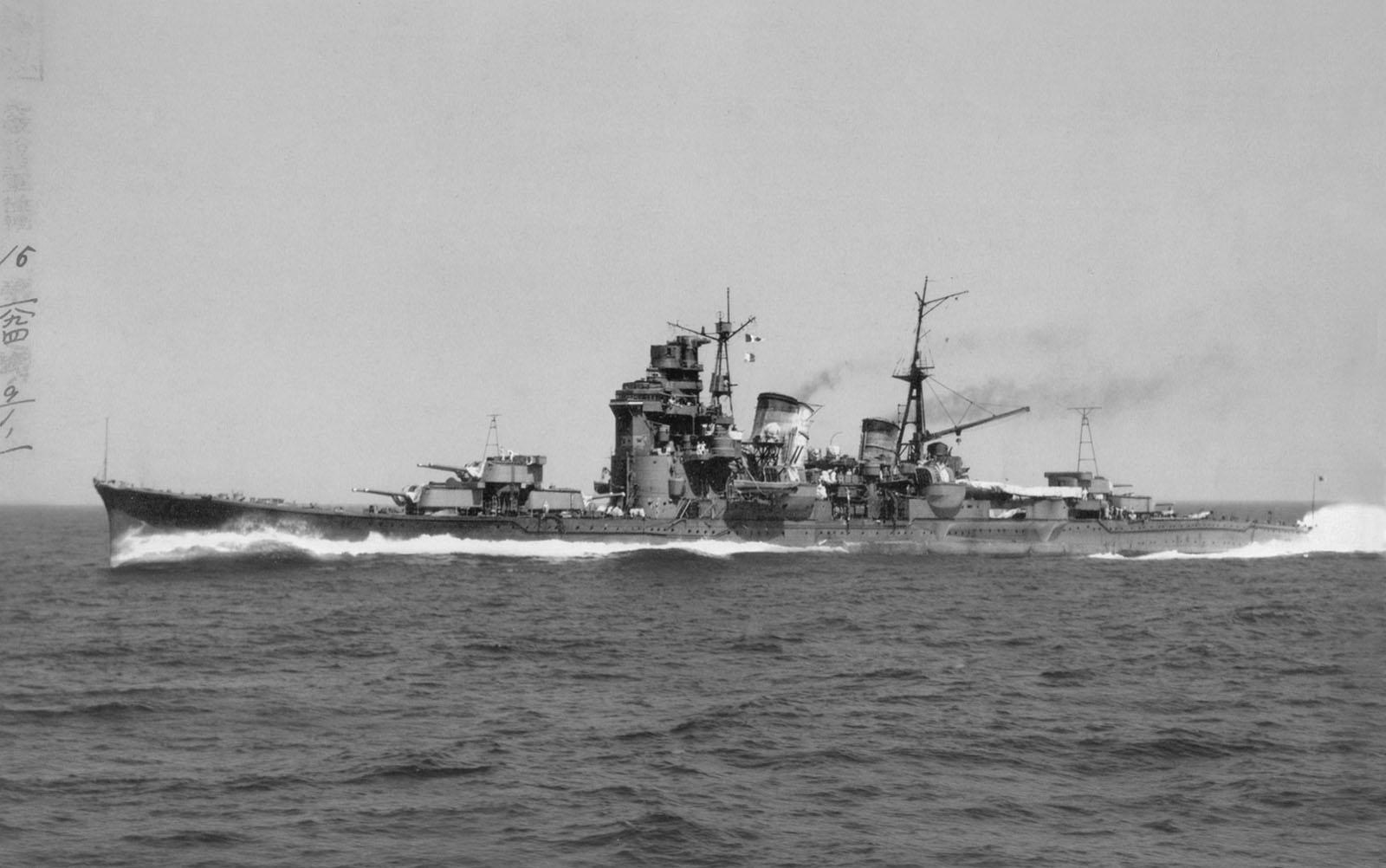
IJN Myoko post-reconstruction in sea trials, 1941
Design of the Nachi class
The design feat of cramming all that on a 200 meters long, slender and light hull announced officially as 10,000 tons standard were also capable of reaching 35.5 knots without excessive power either. The amazing width/length ratio indeed was almost unchanged from the Aoba, the same 12/1. Protection however was greatly improved overall, with a much thicker inner armoured citadel, triple hull and reinforced cross-sections and bulkheads. With successive modernizations this standard tonnage in 1941 reached 11,000 tons. Hiraga was able to keep its design from becoming dangerously top-heavy, by continually rejecting demands from the IJN General Staff, for additional equipments, but still, surviving ships reach 15,933 tons fully loaded in 1945.
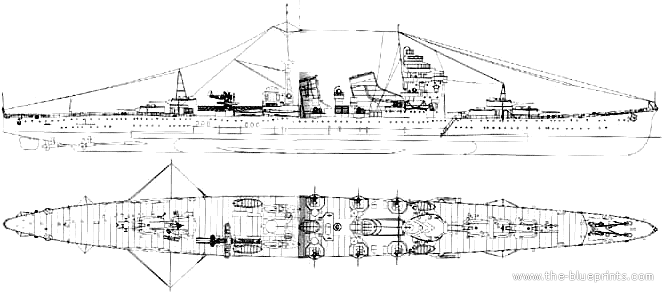
IJN Myoko in 1930
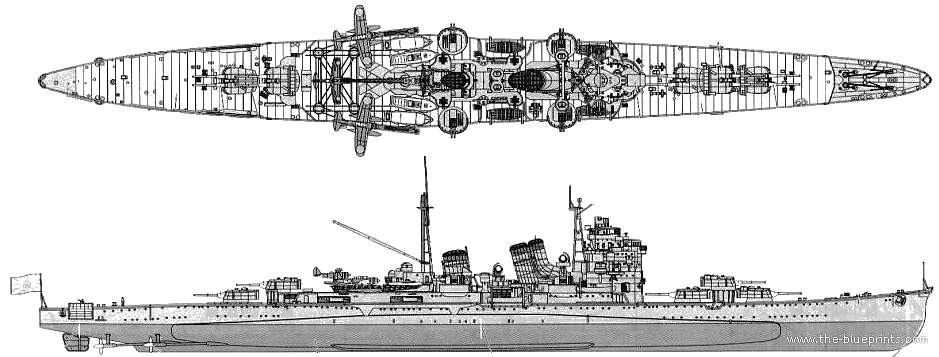
IJN Ashigara in 1942. These two views are an easy way to see the differences between the two. In 1944, a new lattice mast was installed behind the bridge and the aft TTs were removed.
IJN Myōkō the lead launched ship, displaced 13,500 t (13,300 long tons) fully loaded, for exactly 10,000 tonnes standard as declared officially. The hull was basically based on the Aoba-class cruisers (1926), but with significant differences. Flush deck with two slopes on their predecessors, it was straight and levelled on the Nachi over 201.50 to 203.76 metres (661-669 feets) long overall, 193,39 m at the waterline (631 feets 2 inches) and a beam of 17,34 m at the waterline (56 feets 11 in), 19.5 metres (64 ft) overall, draft of 5,90 m standard (19 feets 4 in) down to 6.36 metres (20.9 ft). The hull was sloped downwards after the “Y” barbette and gently raised about 30 m from the bow which design was identical to the Aoba class. Like her, the prow was faired downwards under the waterline, in the rounded “icebreaker” style adopted as a trademark of Hiraga’s designs and repeated on the next Takao class and following.
The differences in width are explained (after reconstruction) by a very slender beam at the waterline, “V” shaped hull downwards, topped by a massive superstructure above the citadel overhanging on both sides on its aft section, where the forward torpedo tubes bank is located. The latter is internal, like the second pair aft, avoiding battle damage. The top view reveals a very well profile hull without any parallel section, the largest beam, with flat sides, is located about 1/3 of the stern. Then the flanks are sloped, making for the finest waterline possible and optimized penetration.
The ratio of 1/12 results in exceptional speeds for a moderately large powerplant, but is of course problematic for fast manoeuvres, heeling wildly in tight turns, hard rudder although this was compensated later by bulges and counter-keels. Outside vibrations, the design indeed suffered from instability, later corrected during refits.
Propulsion

Starboard forward Kanpon turbine set of Myoko configuration
Despite the space available below the waterline, and the width of the ASW protection, Higara managed to install in separated engines rooms, two sets of turbines, fore and aft, and separated boilers rooms, housing two in each of the six rooms forward of the single-impulse geared turbines. As the previous designs, the inwards turbines and propellers were used for cruising, and outwards for speed. All 12 Kampon boilers were oil-firing only, delivering a total output of 130,000 shp (97,000 kW) as indicated, which was superior to most cruisers of the time. The four shafts turned three-bladed propellers. This power, combined with that hull, gave a top speed as designed of 35.5 knots, but in sea trials, 36 knots were easily exceeded (67 km/h; 41 mph). To avoid excessive vibration and hull fatigue, it was in practice reduced to 34-35 knots in service. All four ships also carried 2,470 tonnes of oil, enough for a range of 8,000 nmi (15,000 km; 9,200 mi) at 14 knots (26 km/h; 16 mph), sufficient figures for the pacific.
Protection
The ship was overall better protected than the previous Aoba class. They were armored with a 102 mm (3.9 to 4.0 in) side belt, and a main 35 mm (1.4 in) internal armored deck however, the bridge was not armored to avoid stability problems, and the turrets were protected 0.98/1 inch armour faces (25 mm), and the barbettes were 3 in thick (76 mm), also for stability issues. This meant these turrets were very easy to cripple by even destroyer fire, 5-in guns. Despite these light armour figures, the hull as very well compartmented, with a triple hull at the bottom for at least the central section (below the citadel) and there was an underwater longitudinal arched bulkhead running also along this central section.
Armament
This is the armament as built and completed in 1928-29. See below for the 1930s and WW2 rearmaments.
Main armament
Nachi had a main battery of ten 20 cm/50 3rd Year Type naval guns (1923), which was the heaviest armament of any heavy cruiser afloat in the world at the time, but soon equivalent to the contemporary USN Pensacola class. Both differed in the way this armament was installed, in two triple and two twin turrets of the Pensacola, but five twin on the Nachi.
To compared both guns, officially called “50 caliber 3rd Year Type 20 cm Gun 1 GÔ (No. 1)”, the Japanese ones were not “strict” 8 inches, being exactly lower caliber, as suggests their internal designation 20 cm/50 (7.9″). as compared to 8″/55 caliber naval gun, so real 203 mm and longer range. The Japanese guns fired fast however at 2,854 fps (870 mps) versus 2,500 feet per second (760 m/s) however, but the shell was lighter at 110 kgs (252 ibs) versus 152 kg (335 ibs). Range was 29,200 yards (26,700 m) at 40° versus 31,860 yd (29,130 m) at 41°. The rate of fire was around 3rpm, roughly similar.
The Nachi class was the last to use the Mark I, developed to equip previously the Kaga, Akagi, Furutaka and Aoba classes. She used improved type D turrets. The next Takao class would use the much improved Mark II.
Read more about his gun. These guns were modified during the interwar, upgraded to the 203 mm (8 in) 2 GÔ version.
Secondary armament
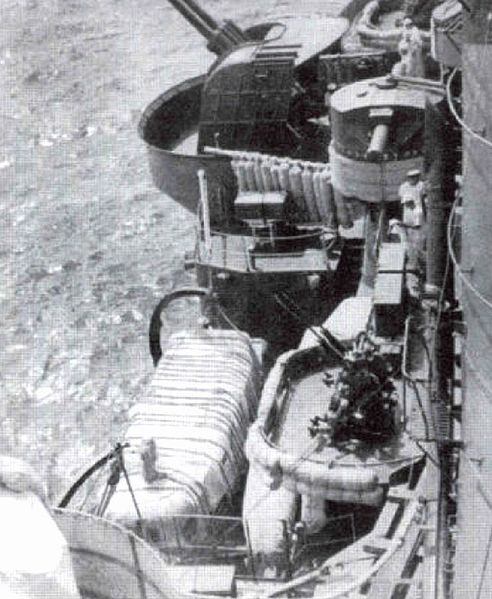
Nachi’s secondary armament included six 4.7 in (120 mm)/45 naval guns in single mounts abreast the funnels. After reconstruction it was changed to four twin mounts 12.7 cm/40 Type 89 (5 inches) at the same place. More on these. This made another point of comparison to the Pensacola class. However, as built in 1929, there was not other lighter AA gun on board, contrary to the Pensacola class, which had four quad 1.1-inch (28 mm)/75 caliber guns as built, so 16 in all.
Torpedo armament
An important point in the design was the use of no less than twelve Type 93 torpedo tubes, in four triple launchers. They were positioned below the aircraft deck on either side, and fixed, so firing a broadside only. In comparison the Pensacola only had two triple banks, which had some traverse, and Mark 15 torpedoes, but still certainly not a match for the Type 93.
Onboard aviation
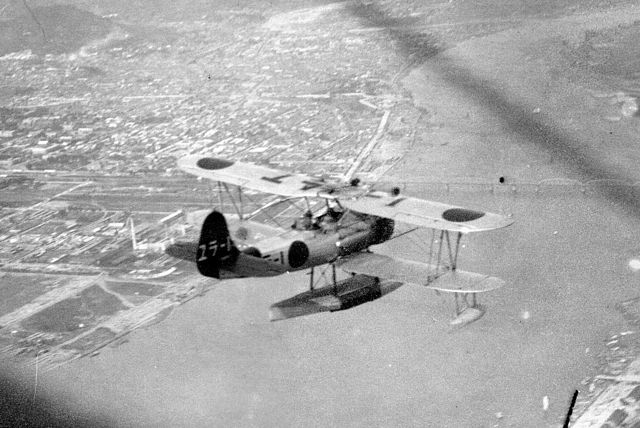
Nachi was equipped with an aircraft catapult aft of the mainmast and placed on the port side, with a lift and hangar in the center. She carried up to three scout floatplanes of various models during her service. It was for long the Nakajima E2N1, then E4N, replaced by the Kawanishi E7K Navy Type 94 after refit, or Nakajima E8N ‘Dave’ and after 1941, the Aichi E13A ‘Jake’. Facilities were modified also during refits (see below).
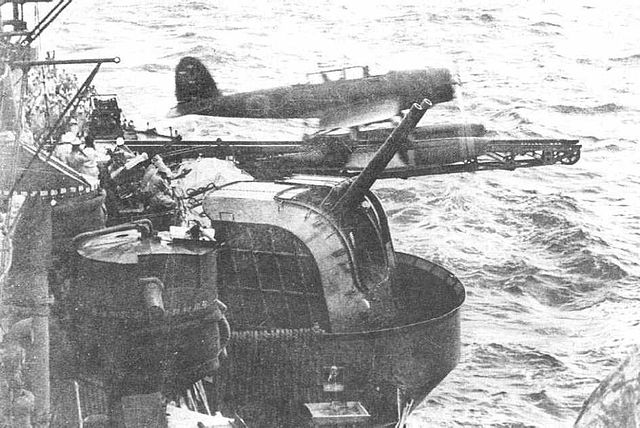
Aichi E13A capulted from IJN Ashigara
Refits and modernizations
Nachi was modernized and upgraded throughout her career, especially after Japan retired from the League of Nations. This was in order to improved her AA capabilities, and at first, just two single 7.7 mm/80 machine guns were installed.
-1932: Myoko, Nachi (early 1934 for Haguro and Ashigara) had her five twin 200 mm/50 guns upgraded to the 3-shiki 203 mm 2-go gun mount.
-1935: All four received four twin 127/40 89-shiki, and four quadruple 610 mm TTs (16), plus 2 new catapults port and starboard, no hangar, and rails to store and manage three seaplanes of the E4N type. New additional bulges were fitted for better ASW protection, and breadth was now 19.0m. Full displacement rose to 15,313 or 15,391 tonnes fully loaded, more than 13,000 standard, way above Washington treaty limits. Top speed however was reduced due to the added weight, to 34knots. By the end of the year, they were also given their first light AA, two quadruple 13.2mm/76.
-1939-41: Haguro was refitted first, followed by Nachi both between 1939 and 1940, then Ashigara and Myoko in 1940-41. They were all ready before the attack on pearl harbor. They carried an additional four twin 25 mm/60 96-shiki AA guns and two twin 13.2mm/76, but just two quadruple 610 mm TT and 24 reloads. New catapults were fitted and fuel stowage was sacrificed, down to 2214t. Bulges were modernized an larger ones adopted, increasing the beam to 20.7m, draft to 6.40 m. Displacement rose to 12,071-12,342 tonnes standard and up to 15,840-16,007 tonnes fully loaded, while top speed fell to 33.3kts.
-1942: Four twin 25mm/60 96-shiki, 4 DCR (12 in storage), 1-shiki 2-go radar.
-1943: Addition of eight single 25mm/60 96-shiki
-1944: 610 mm Torpedoes storage reduced to 16, addition of four triple 25mm/60 96-shiki, and sixteen single plus two shiki 2-go, and three shiki 1-go radars, new lattice mast. By the fall of the year, Ashigara and Nachi receved two of the new quadruple 619 TTs (16) and two additional twin 25/60 96-shiki, plustwenty single 25/60 96-shiki. Grand total for AA: 52 Type 96 25 mm AT/AA Gun guns and two Type 93 13 mm AA guns after her final upgrade.
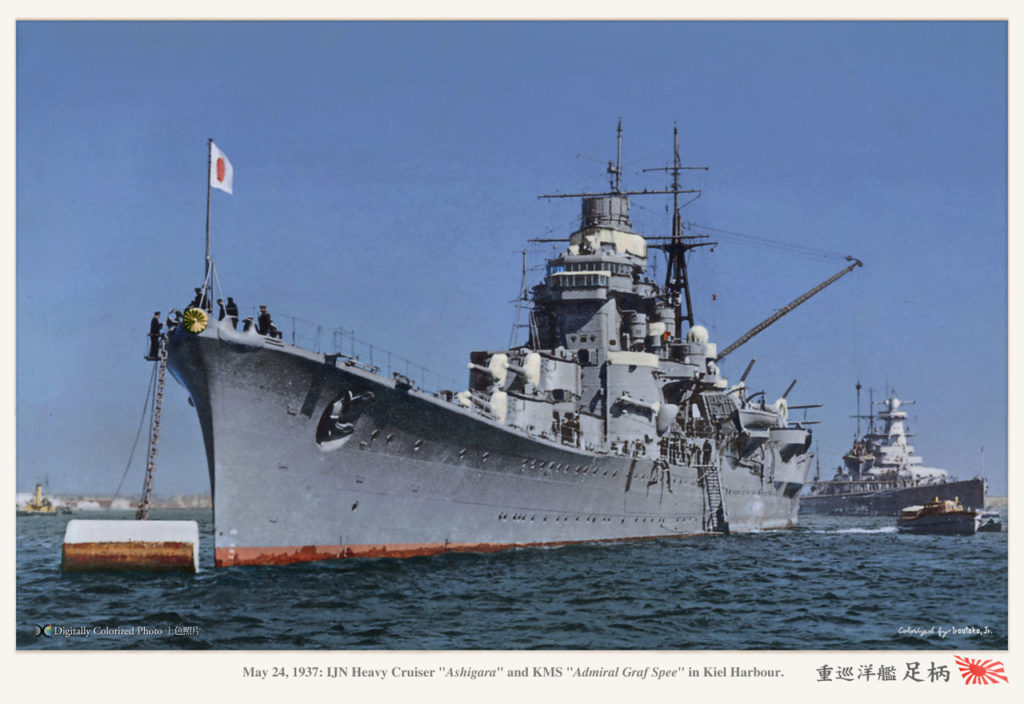
IJN Ashigara an the Gref Spee in the background at Kiel in March 1937. Colorized photo by Hirootoko JR.
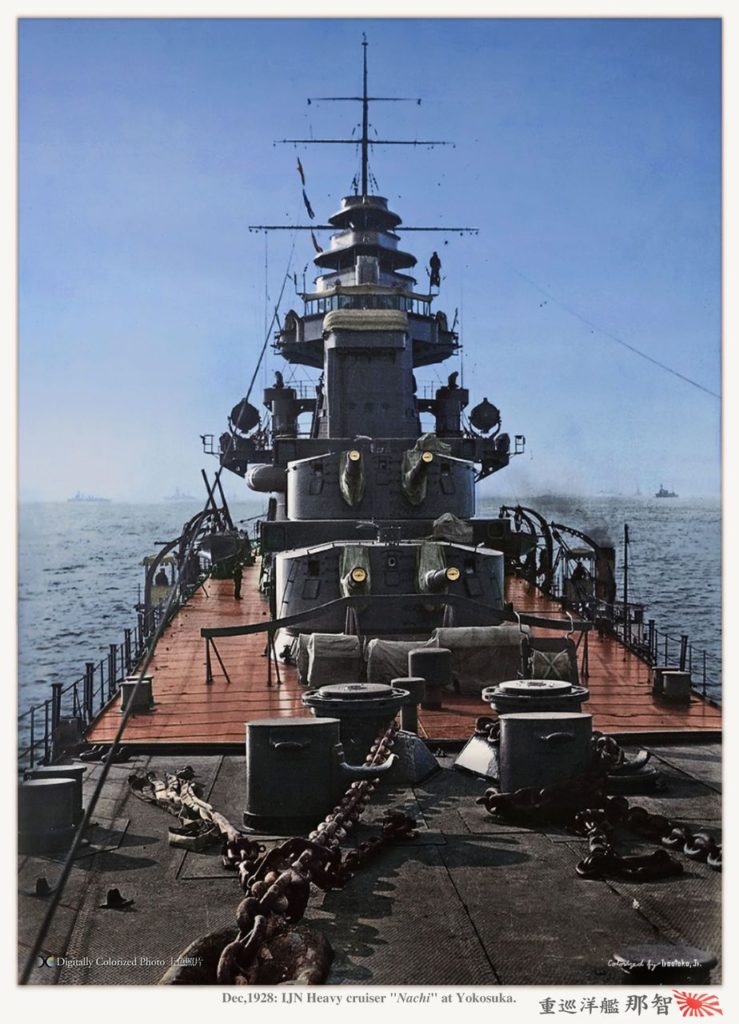
IJN Nachi in Yokosuka in the 1920s. Colorized photo by Hirootoko JR.
Specifications (1941)
Displacement 13,000 t. standard -14,740 t. Full Load
Dimensions 203.76 m long, 20.60 m wide, 5.66 m draft
Propulsion 4 propellers, 4 turbines, 12 boilers, 130,000 hp.
Top speed 34 knots
Armour from 100 to 25 mm
Armament 5×2 203mm (8 in), 4×2 127mm (5 in), 8 x 25 AA, 12 x 13.2 mm AA, 16 x 610 mm TTs, 3 aircraft
Crew 773
Read more
//www.world-war.co.uk/japan/myoko.php
//combinedfleet.com/ships/myoko
//www.navypedia.org/ships/japan/jap_cr_nachi.htm
//ww2db.com/ship_spec.php?ship_id=472
//pwencycl.kgbudge.com/M/y/Myoko_class.htm
The Myoko class on Kagero
On Scalemates
ONI 222 IJN reco. handbook
FCM30-50 ONI reco handbook
ONI Japanese Merchant Marine reco handbook
Conway’s all the world fighting ships 1922-45
Lacroix, Eric; Linton Wells (1997). Japanese Cruisers of the Pacific War. Naval Institute Press.
Stille, Mark (2011). Imperial Japanese Navy Heavy Cruisers 1941-45. Osprey Publishing Ltd.
Tamura, Toshio (2004). “Re: Japanese Cruiser Torpedoes”. Warship International. XLI (4)
Whitley, M J (1995). Cruisers of World War Two: An International Encyclopedia. Arms and Armour Press.
IJN HEAVY CRUISER MYOKO-CLASS PICTORIAL BOOK, GAKKEN REKISHI-GUNZO Nr. 27
IJN Myoko Class Cruisers, Warship Pictorial Nr. 17, Steve Wiper

Nachi 1945 – author’s HD schematics based on conway’s reference (note: no longer accurate)

Myoko, camouflaged in 1944 (Made in 2000, updated 2021).
Note: Modern, HD illustrations of all four cruisers are coming.
The modeller’s corner
-1:200 IJN Nachi (Answer-Angraf)
-1:350 Haguro, Ashigara, Nachi, Myoko (Aoshima)
-Aoshima 1:700 all four
-1:400 Haguro, Myoko (Tamiya)
-Also 1/700 all four, Tamiya
-Nichimo 1:500 all four
More
The Nachi class in action
IJN Myōkō
Early service
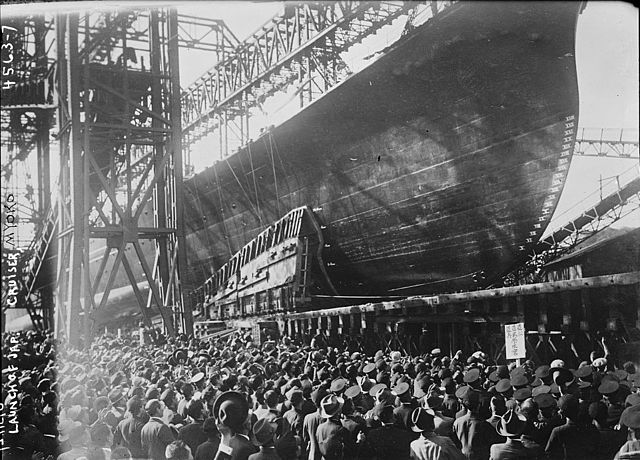
The launch of Myoko in 1927
The Imperial Japanese Heavy Cruiser IJN Myōkō was laid down at Yokosuka Naval Arsenal, on 25 October 1924. She was launched and christened “Myōkō” (after Myōkō-shi, an old city located in Niigata Prefecture) on 16 April 1927. The launching ceremony was attended by Emperor Hirohito. She was commissioned on 31 July 1929 under command of captain Fujisawa Takuo. First ship in her class to be laid down and launched (which is why authors are divided to name of the class, either Myoko or Nachi), she was the third to be completed. IJN Nachi was first.
Myōkō was modernized and upgraded as her sister ships several times during her 20 years long career.
The four cruisers, completed in 1928-29 were all assigned to the same unit, Sentai-4, 3rd Fleet, based at Sasebo Naval District. They trained together for all the 1930s. One of the earlier modifications was due to smoke bellowing on the bridge during a naval review in Kobe, on 26 October 1930. Therefore the forward raked smokestack was lengthened by two meters to avoid this interference.
The First Shanghai Incident of February 1932 saw the four cruisers escorting the troop transports bound to the continent. In December 1932, the wole class was placed in reserve as the new Takao-class were commissioned. The latter took their place as Sentai-4 and the Myōkō-class were relegated to Sentai-5. In 1933-1935, the while class was refitted with two quadruple rotatable launchers, and new secondary guns (see the modernization details). As the Second Sino-Japanese War broke out, IJN Myōkō took part in the Amoy landings, 10–12 May 1938. She was flagship of Sentai-9, 5th Fleet and would took part in the Hainan Island Operation in February 1939. Her second refit and modernization started, completed in April 1941. Not only she had double the number of “Long Lance” torpedoes but gained also many extra AA guns and new bulges, more for extra stability than ASW protection.
Invasion of the Philippines
When the Pearl Harbor attack too place, IJN Myōkō and Nachi formed a single unit, Sentai-5 affected to the 3rd Fleet (Rear Admiral Takeo Takagi). They left Palau and were intended to cover the landings of “Operation M”, invasion of the southern Philippines, starting at Legaspi on 11 December 1941. Myōkō and Nachi then headed back to Palau, reassigned to Rear Admiral Raizō Tanaka, and covering the landings at Davao (19 December), Jolo (24 December). On 4 January 1942 Admiral Tanaka’s force was attacked by USAAF B-17 bombers, at anchor. Myōkō was hit by a single 500-pound (227 kg) bomb. This however caused only superficial damage and she was repaired in drydock at Sasebo.
Battle of the Java Sea
On 1 March 1942 Myōkō, Nachi and Haguro teamed in an operation targeting ABDA, the remainder of allied fleets in the area, protecting the Dutch East Indies. At 11:50, Myōkō, Ashigara separated with their escort, the destroyers Akebono and Inazuma. They opened fire on the HMS Exeter and her escort and Myōkō claimed her, with her sister-ship that day. They also crippled the destroyer HMS Encounter, latter scuttled. Myōkō was later refitted at Sasebo and April hunted down for the Doolittle raid task force (which was never caught)
Battle of the Coral Sea
In May 1942, Myōkō covered a fraction of the Kido Butai, main Japanese Carrier Strike Force, in Operation Mo, covering the Tulagi invasion force. This was met with resistance, and ended with the Battle of the Coral Sea where she served as flagship fro Vice Admiral Takeo Takagi in overall command of the Carrier Strike Force (Shōkaku, Zuikaku, Rear Admiral Chūichi Hara) teaming with Haguro and five destroyers. Shōkaku was damaged and Zuikaku lost most of her air group, forcing a general withdrawal and saving Port Moresby.
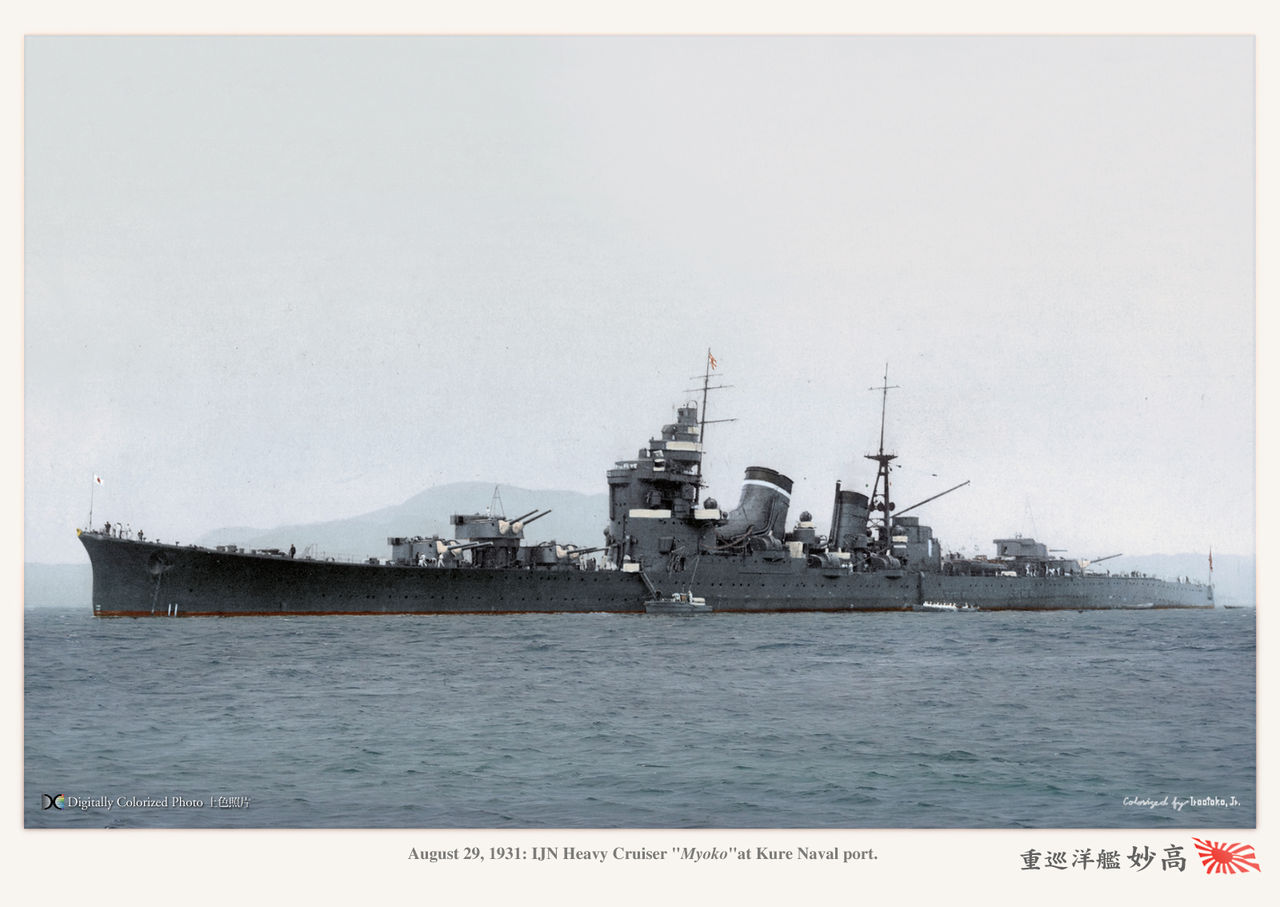
Myoko in Kure, 1931 – Colorized by Irootoko Jr.
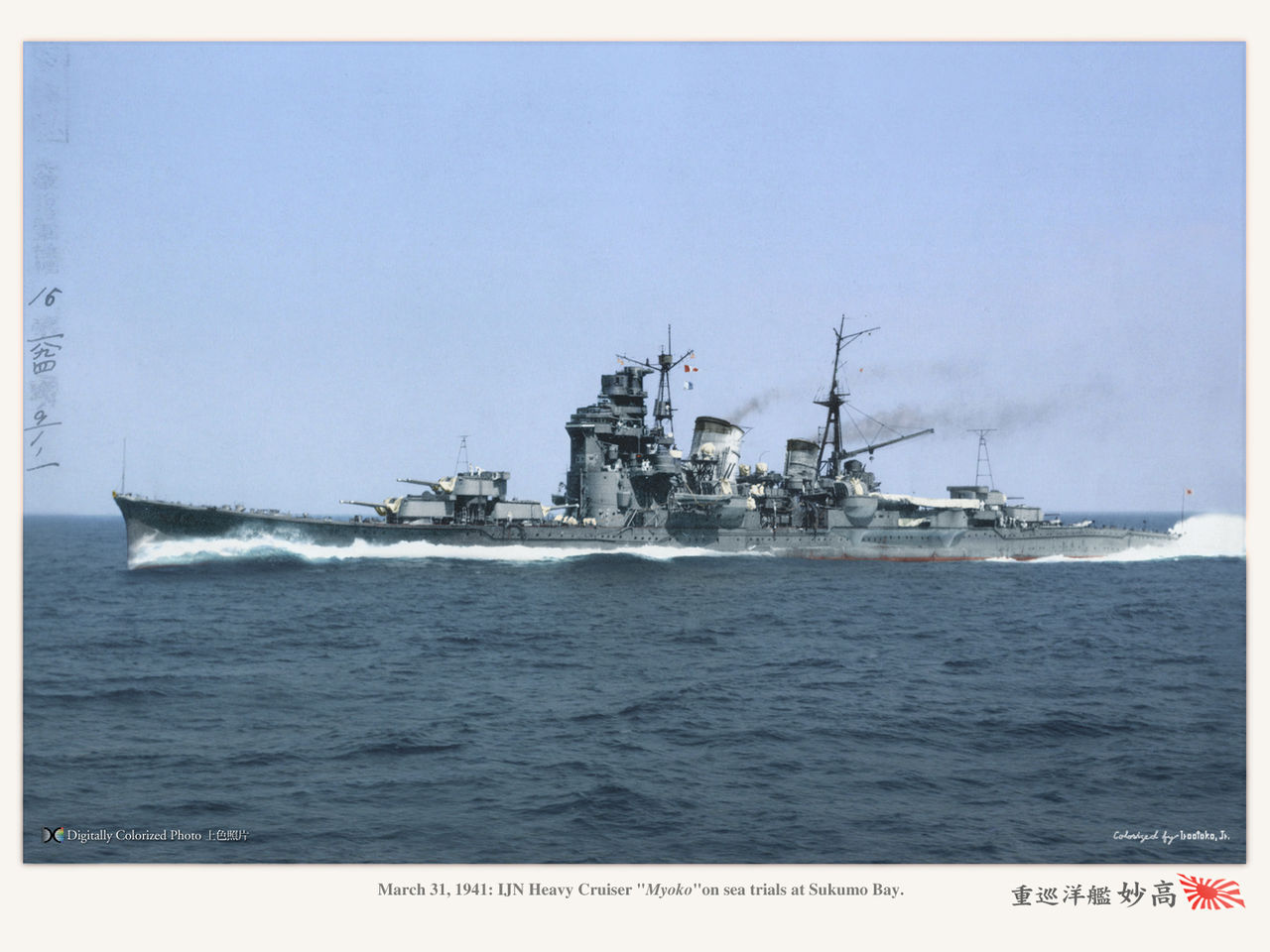
Myoko in post-reft sea trials, 1941, same.
Battle of Midway
In June 1942, Myōkō was place under command of Vice Admiral Nobutake Kondō’ covering his Support Force off Midway, as part of a fleet also comprising IJN Kongō and Hiei, and the cruisers Haguro, Atago and Chōkai, Yura, the light auxiliary aircraft carrier Zuihō, and seven destroyers. This Support Force saw no action during the battle and returned to Sendai on 23 June.
Aleutians Campaign
Myōkō was detached on 28 June to escort a convoy in the Aleutian Islands, covering the aircraft carriers Zuikaku, Zuihō, Jun’yō and Ryūjō, and teaming up with Maya, Takao, Haguro, Nachi, Abukuma, Kiso and Tama. The while fleet returned to Hashirajima on 12 July 1942, meeting no resistance.
Solomon Islands campaign
On 11 October 1942, Myōkō was in Truk, affected to the 2nd Fleet. She departed with Kongō and Haruna, Atago, Chōkai, Nachi, Isuzu and twelve destroyers and preceded Vice Admiral Chuichi Nagumo’s Carrier Striking Force. Their mission was to escort troopships to reinforce the garrison of Guadalcanal, invaded by US troops in last August. Myōkō on 14 September was targeted by USAAF’s B-17 bombers but only suffered light damage from near misses. On 15 October (at night), she bombarded Henderson Field with Maya. From 31 January and until 9 February 1943, Myōkō, which was refitted recently as Sasebo, covered the evacuation of Guadalcanal, also under cover from Zuikaku, Zuihō, Jun’yō, Kongō, Haruna, and the cruisers Atago, Takao, Myōkō; Haguro, Nagara and Agano plus 11 destroyers. In total, the evacuation of 11,700 troops was a success.
1943 Operations
In May 1943, Myōkō and Haguro returned to the Aleutians to help evacuating Kiska island. In June 1943 both were refitted at Sasebo, gainung four twin Type 96 25 mm AT/AA Gun mounts, and a Type 21 air search radar. They were scrambled to answer the US attack on the Gilbert Islands. Myōkō (under command of Vice Admiral Jisaburō Ozawa as flagship) was sent to track down the American carriers, with Shōkaku, Zuikaku, Zuihō, battleships Yamato, Nagato, cruisers Myōkō, Haguro, Tone, Chikuma, Mogami, Atago, Takao, Chōkai and Maya, Agano and fifteen destroyers. Making no contact, the force returned to to Truk. Myōkō and Haguro sailed on 1st November 1943 with two destroyers for a convoy escort to Rabaul and from there, joined Agano and Sendai, six destroyers to escort another convoy to Bougainville of 1,000 IJA troops, and the heading cruisers met and engaged theur US counterparts in what became the Battle of Empress Augusta Bay on 3 November 1943. The US force comprised light cruisers and eight destroyers. They sank Sendai with gunfire but while manoeuvering, Myōkō collided with Hatsukaze, latter finished off by USN gunfire. Haguro received minor damage and the USN lost the destroyer USS Foote by torpedo.
1944 Operations
On 17 November 1943, was refitted at Sasebo, receiving more AA. In January 1944 Myōkō sailed wth Tone and two destroyers from Truk to Kavieng and back, escorting a convoy. On 10 February she teamed up with Atago and Chōkai plus eight destroyers, while she was attacked by the submarine USS Permit, but the latter’s salvo missed. In March 1944 Myōkō teamed with Shiratsuyu to escort an empty tanker convoy from Palau to Borneo. On 6 April, she was ambushed by the submarine USS Dace, which fired and missed an latter the USS Darter which could not manoeuvre in time to attack her.
In June 1944, the heavy cruiser participated in the Battle of the Philippine Sea, saling with the rest of the fleet from Tawi Tawi after the invasion of the Marianas Islands. The main threat seemed to be now the heavy bombers based in the Marianas now in range of Japanese home islands. The “Great Marianas Turkey Shoot” followed, as the IJN lost some 300 Japanese carrier-borne planes (and its last finest pilots) on 19 June 1944.
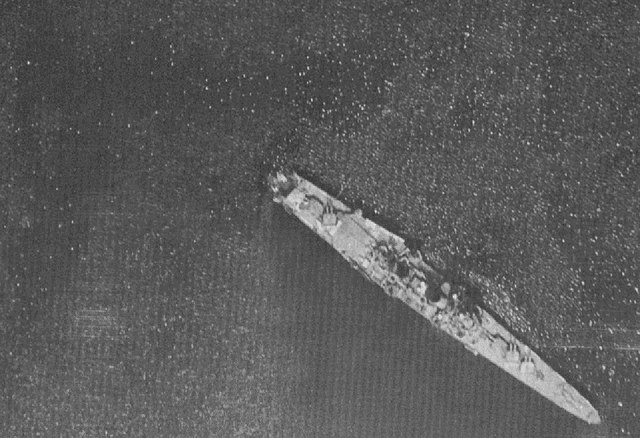
Myoko in Singapore, aerial reco photo, 1945
Myōkō also participated in the Battle of Leyte Gulf while in Vice Admiral Kurita’s First Mobile Striking Force, comprising four battleships and ten cruisers. Called the Center Force, it made its way unannounced through the Sibuyan Sea and fell on US Task Force 38. During the battle, Myōkō was hit by a torpedo, aft on the starboard side. She had her starboard propelers damaged, broke off and limped to Singapore at 15 knots (28 km/h; 17 mph) for repairs. She arrived on 2 November 1944 and departed for Japan, stopping en route at Cam Ranh Bay, when she was ambushed by the submarine USS Bergall at 17:35, on 13 December 1944. The latter fired a full salvo of six, and she took a single hiy on her aft port side. This impact blew her unprotected stern. Te whole steering mechanism was badly damage and unresponsive so she ended dead in the water. She could only count on her port screw to still sail at 6 knots, helping her towing by the destroyer IJN Ushio which previously attacked and repelled USS Bergall. She was escorted to Singapore but due to insufficient materials for complete repairs she was left there waiting her fate, together with the badly damaged Takao, after another submarine attack just before the battle of Sibuyan.
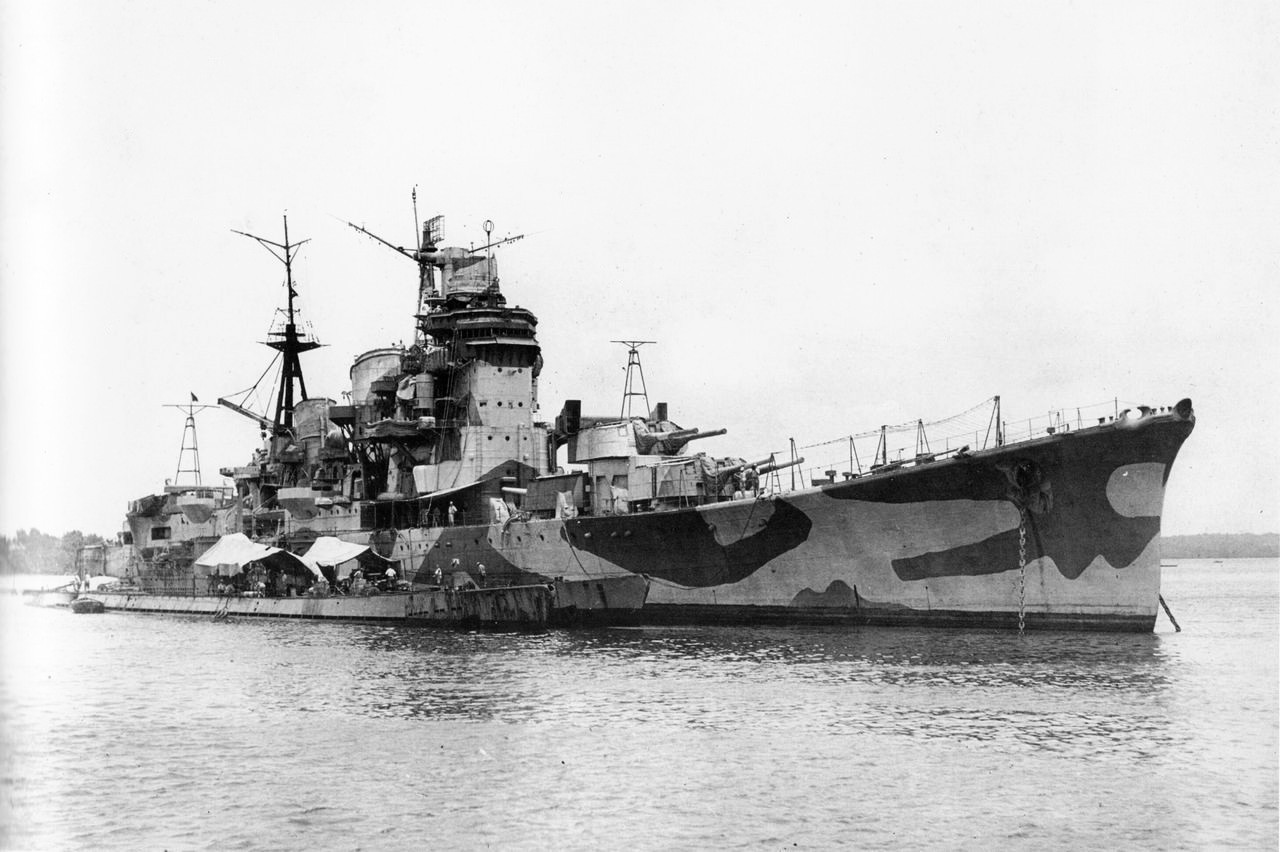
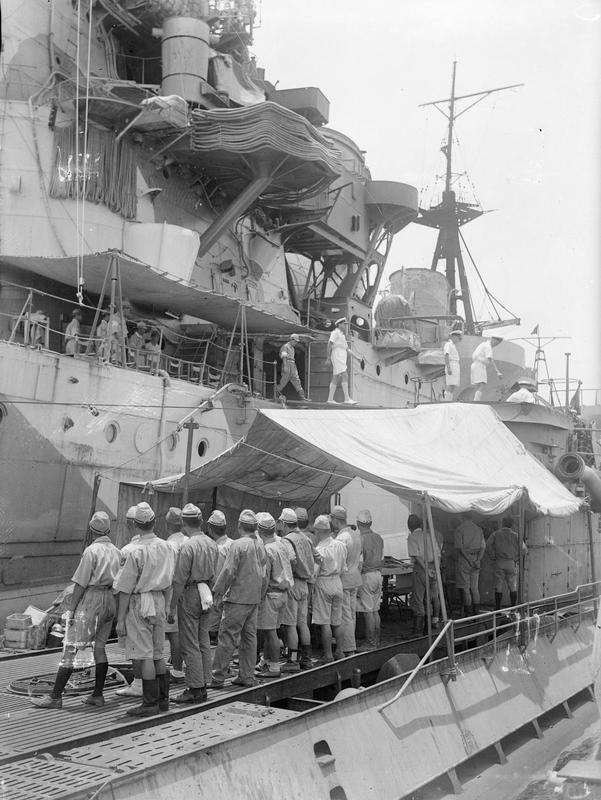
IJN Myoko surrendering to British troops in a ceremony in 1945
Fate of Myōkō (1945)
In February 1945, an IJN inspection team determined Myōkō cold not be repaired at Singapore and could not be towed to Japan either. She stayed in Singapore as a floating AA battery with Takao. but both were targeted by British commandos, manning midget submarines, whith attacked them on 26 July, despite of this, she survived this new attack, and the war. Formally surrendered to the Royal Navy on 21 September 1945 she was towed to the Strait of Malacca and scuttled off Port Swettenham in Malaya as well as the submarines I-501 and I-502.
IJN Nachi
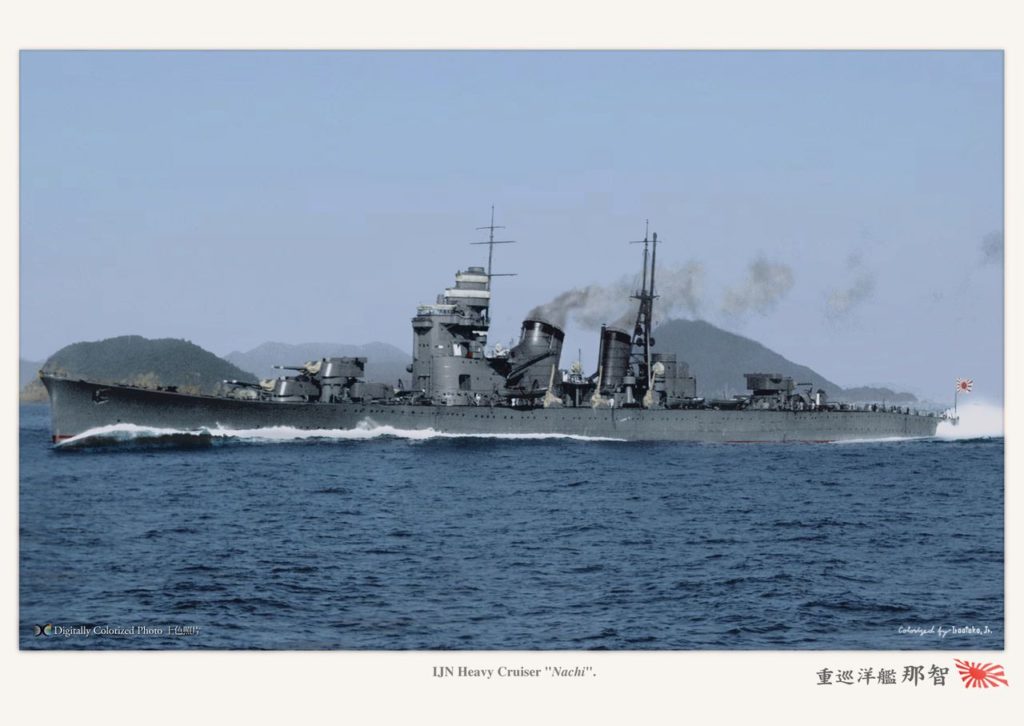
Cruiser Nachi on sea trials in 1929, showing her first appearance. Colorized photo by Hirootoko JR.
Like her sister-ships, Nachi, the first completed in this class, was based at the Sasebo Naval District part of Sentai-4, 3rd Fleet. Her first refit was lengthening of the forward smokestack and in 1932 she participated in the events following the first Shanghai Incident, escorting transports. By December 1932, she was reaffected to Sentai-5 and until 1935, she underwent her first major refit. Captain Teruhisa Komatsu took command in the meantime, followed by Captain Michitaro Totsuka from November 1936. As the second Sino-Japanese War on 20 August 1937, she transported HQ elements of the IJA’s 3rd Division and 6th Infantry Regiment as part of a force of six cruisers and eight destroyers. By December her second modernization started at Sasebo Naval Arsenal.
1942
Nachi was the Mako Guard District, Pescadores Islands in December 1941, Sentai-5, 3rd Fleet (Rear Admiral Takeo Takagi). First she was deployed from Palau to cover the landings of “Operation M” (Philippines invasion). Under Rear Admiral Raizō Tanaka she also covered landings at Davao and Jolo. On 4 January 1942 her units was attacked by B-17s without much damage and she became flagship for Admiral Tanaka while Myōkō was sent to Sasebo for repairs.
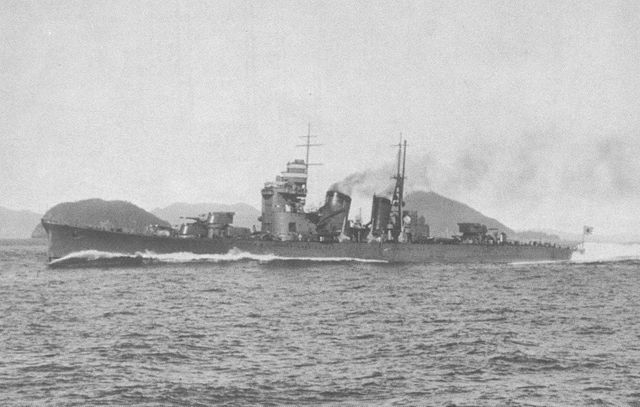
Nachi’s sea trials in 1929 (original)
After covering landings in the Celebes, Dutch East Indies, and Ambon later, the fleet looked after the allied combined fleet. The matter was settled at the Battle of the Java Sea, and later Nachi and Haguro (plus Jintsū) chased down the last remants for the ABDA. On 27 February, these were Nachi’s floatplanes that spotted the Allied fleet, and Nachi sank HNLMS Java by torpedo. Two days later Nachi and Haguro spotted and catch up with Exeter and sank her.
March 1941, Nachi was refitted at Sasebo to later operate in the Kurile Islands by April-May in a fleet commanded by Vice Admiral Boshiro Hosogaya. The Aleutian islands was lackluster and quiet, and she was back in Japan by 23 June, but departed Ōminato to escort another convoy to Kiska and remained there until 7 July. She was refitted in Yokosuka 14–30 July, assigned to the 5th Fleet and went on patrolling the Kurile Islands until March 1943, escoting yet another convoy to Attu in 7–10 March.
1943:
On 26 March, Nachi’s planes spotted a small US fleet comprising the cruisers USS Richmond and Salt Lake City, the destroyers Bailey, Dale, Monaghan and Coghlan. Vice Admiral Hosogaya on his side, in addition to Nachi had the Maya, Tama, and Abukuma and two destroyers. Nachi’s aircraft were in the air after she opened fire and the starboard one was damaged during the fire by the blast. The remaining one was launched afterwards. The Battle of the Komandorski Islands saw at some point closing enough to launch her Type 93 “Long Lance” torpedoes. The battle lasted for four hours, and both Salt Lake City and Bailey were damaged, while Nachi took five hits. Hosogaya abandoned his reinforcement of Attu and decided to withdrawn. He was later sacked for this, and relieved of command in disgrace.
After reparations in Yokosuka, and new AA, Nachi sailed to Paramushiro on 15 May, and Kiska in 10–15 July, starting the evacuation of the Japanese garrison. On 6 October 1943 while en route from Japan she was ambushed by USS Halibut. One of the four torpedoes, struck Nachi, on her starboard side, it as often, it was a dud. Nachi stayed in Ōminato until July 1944, in semi-reserve.
Operations in the Philippines

Nachi in the late 1930s
1944-45:
Nachi was fully reactivated at Kure Naval District on 31 July 1944. In August she was training her new crew while her AA defences were reinforced. In October 1944, she joined the Philippines forces, under command of Vice Admiral Kiyohide Shima. At the Battle of Leyte Gulf Nachi and Ashigara teamed up in Vice Admiral Shoji Nishimura’s force. On 25 October, after te Battle of Surigao Strait, Nachi and Mogami collided and the former was wihtdrawn to Manila for bow repairs. But on 29 October, Nachi, and Kumano als there were bombed and strafed by the US aviation, from Task Force 38. Nachi was hit by a bomb, hitting her aircraft deck. She lost 53 and repairs went on for more months. On 5 November she was attacked by three waves from USS Lexington and Ticonderoga. On the second, she took five hits and 2-3 torpedoes while underway. The Third wave counted for five more torpedoes (all on the port side) and twenty bomb hits. She had her bow and stern cut, and was soon a burning wreck. At the time, Vice Admiral Kiyohide Shima was not on board but saw all the scene. After burning fiercely as she sank, she blew apart, northeast of Corregidor. 807 sailors drawn, including the captain, 220 survived picked up by IJN Kasumi and Akebono.
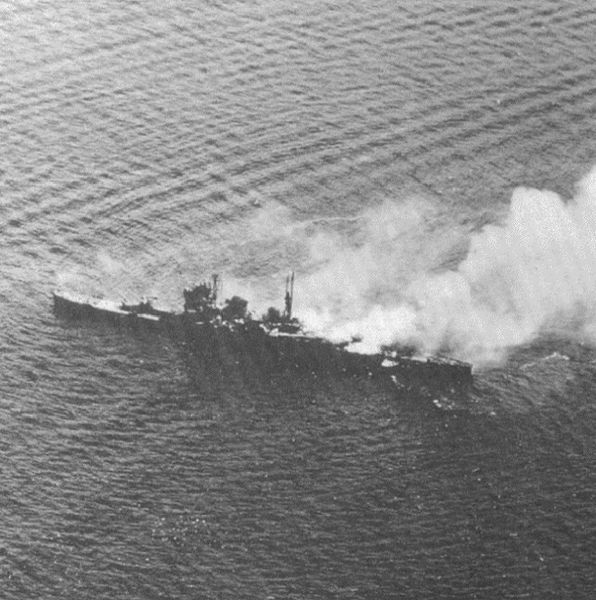
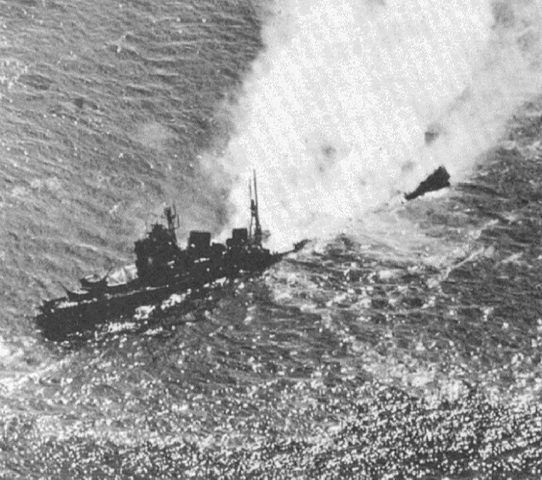

The sinking of Nachi, Battle of Manila Bay, 5 November 1945
IJN Haguro
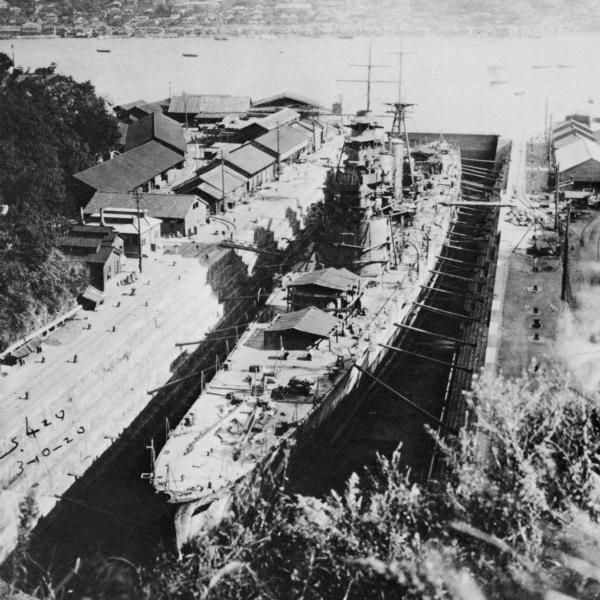
IJN Haguro in construction at Mistubishi NyD, Nagasaki, 1928
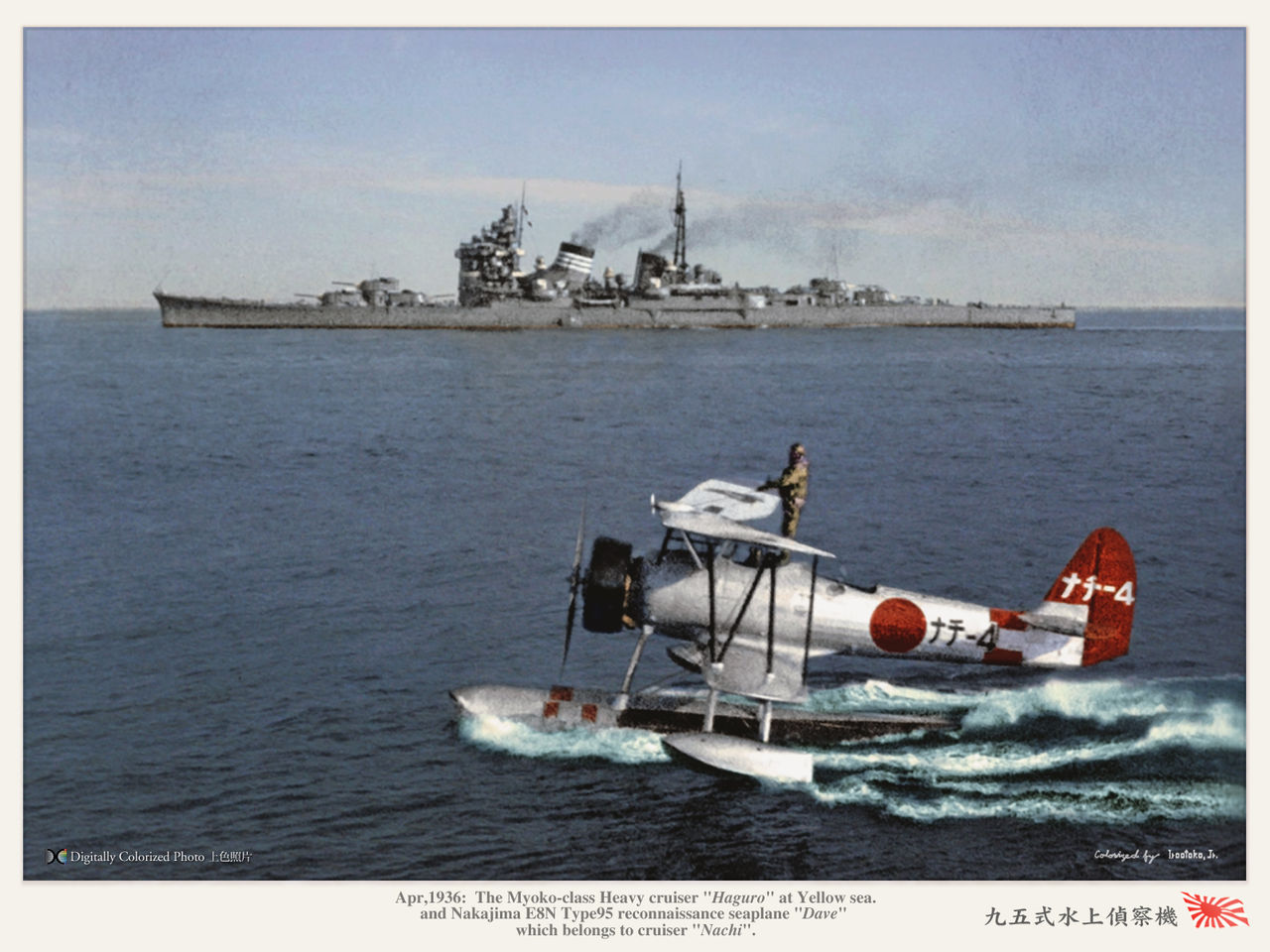
IJN Haguro in the Yellow sea, 1936 – Colorized by Irootoko Jr.
IJN Haguro, Yamagata was named after a city in the Higashitagawa District and was laid down at the Mitsubishi shipyard, Nagasaki on 16 March 1925. Launched on 24 March 1928 she was commissioned on 25 April 1929 and from 1931 up to 1933 under captain Nomura Naokuni she trained, as part of the 4th Sentai, 3rd Fleet with her sister-ships. Nothing notable come to mind for the interwar perdiod. Haguro received the two refits her sister-ships underwent, the last raising their deep load displacement to above 16,000 tonnes. She participated in convoy escorts during the operations in China, in 1932 and from 1937, up to her refit in 1939. Her first combat debut was in the Dutch East Indies, at the battle of Makassar, 8 February 1942. IJN Haguro was also a key player in the Battle of the Java Sea on 27 February 1942, sinking the destroyer HNLMS Kortenaer and Doorman’s flagship, HNLMS De Ruyter, in both cased by using the deadly “long lance” torpedo. HMLNS De Ruyter was by no means able to resist her, being only a modern light cruiser. Barely two days later, on 1 March 1942, off Borneo, IJN Haguro battered and sank HMS Exeter with another cruiser, and her escort the destroyer HMS Encounter.
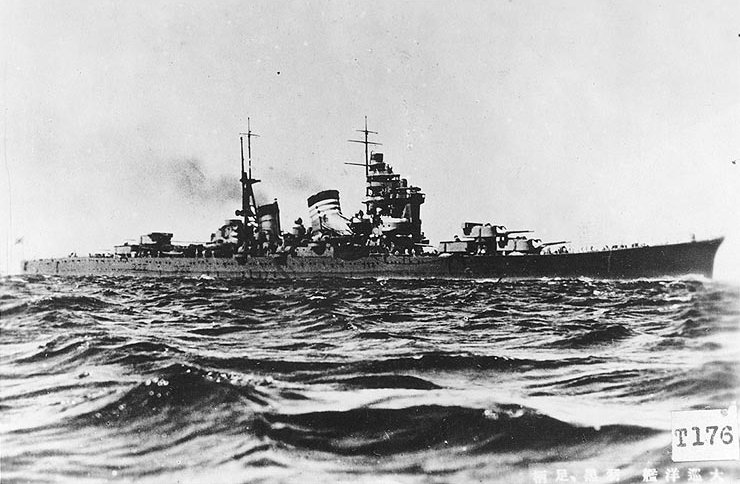
IJN Haguro in 1929
On 7 May 1942, she took part in the Battle of the Coral Sea. Later she operated in the Solomon Islands, covering landings, convoy of reinforcements and shelluing Henderson field. She was able also to take part in the Battle of the Eastern Solomons, 24 August 1942, and the evacuation of Japanese troops from Guadalcanal at the end of January 1943. At the Battle of Empress Augusta Bay, 2 November 1943 Haguro also took an active part and was lightly damaged. On 19 June 1944, was at the Battle of the Philippine Sea, survived the onslaught, and in 23–25 October 1944, took some damage at the Battle of Leyte Gulf.
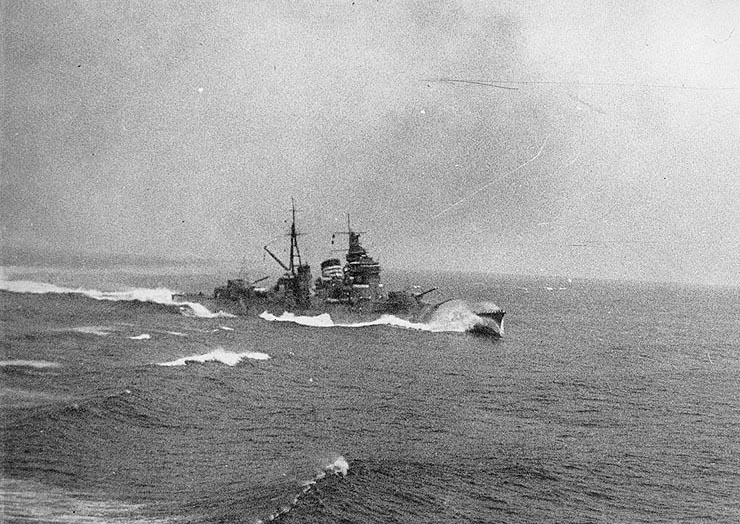
IJN Haguro underway in 1936
The end: Battle of the Malacca Strait (May 1945)
In May 1945, war was over in Europe, and IJN Haguro already veteran of a dozen battles en engagements, became a target during the British Royal Navy “Operation Dukedom“. She was spotted and hunted down by the 26th Destroyer Flotilla, while she only had the destroyer Kamikaze as sole escort. The attack happened just after midnight, on 16 May 1945. IJN Kamikaze was lightly damaged, but Haguro both received concentrated gunfire and three Mark IX torpedoes hits. Slowing down, she started to list 30-degree to port and around 02:32, started to sink, stern first, in the Malacca Strait. It was about 55 nautical miles (48 nmi; 89 km) off Penang. Kamikaze, which survived, rescued 320 survivors but the cruiser went down with 900 men and Vice Admiral Hashimoto, as well Rear Admiral Sugiura, and the captain. At that point, she was the last major Japanese warship sunk in a surface action. She was officially stricken on 20 June 1945.
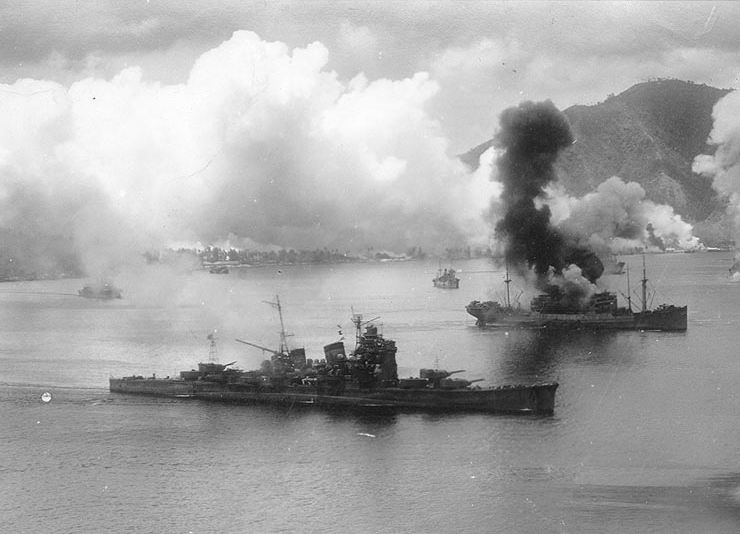
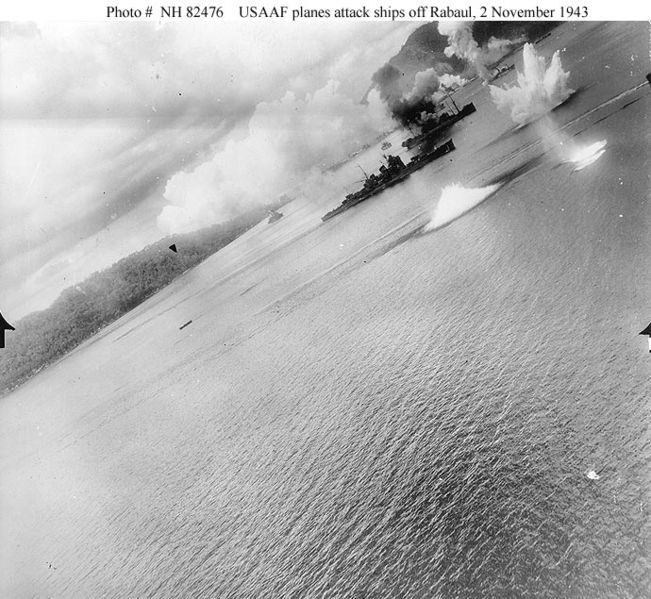
Haguro at Rabaul
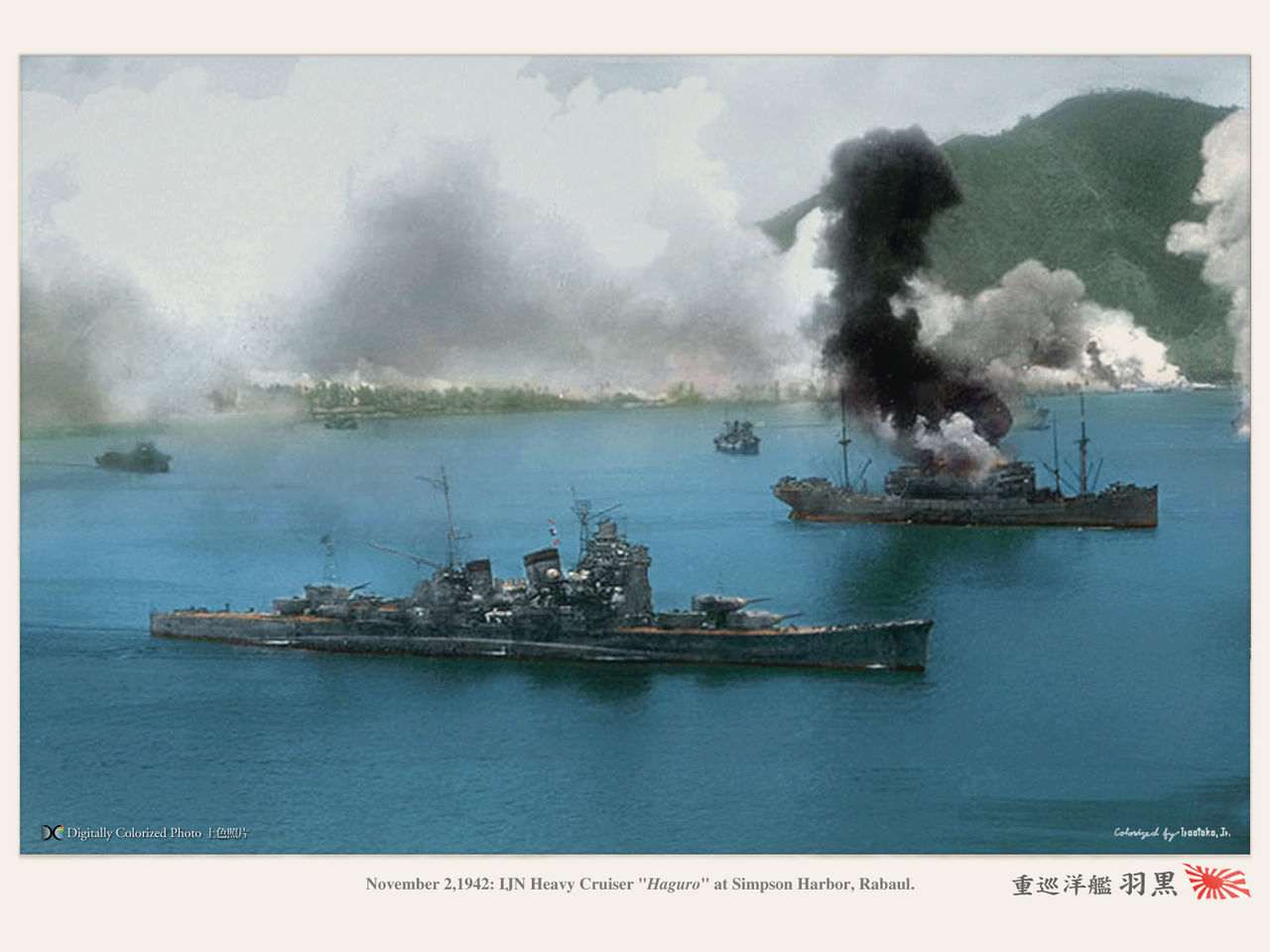
Same photo colorized by Irootoko Jr.
Her wreck was rediscovered on 4 March 2003 and explored by a group of specialised shipwreck divers (MV Empress). She layed 67 metres (220 ft) beneath the surface in the Malacca Strait, upright, and covered by discarded trawler nets and partly buried in the seabed at the level of her waterline, up to her stern well above the seabed. Mats, bridge, and most superstructures collapsed, and many elements missed like her funnels. One torpedo torned down and broke her bow, her No.1 turret and its barbette were lying out of the hull on the sea bed, No.2 turret trained full starboard had her roof collapsed, barrels and breeches missing (never repaired battle damage at Leyte Gulf). No.3 turret was trained to port and her stern turrets pointed astern while the wreck is broken in half behind them. There was another expedition in 2010 and she has been reported in 2014 to have been pillaged and further destroyed as a result.
IJN Ashigara
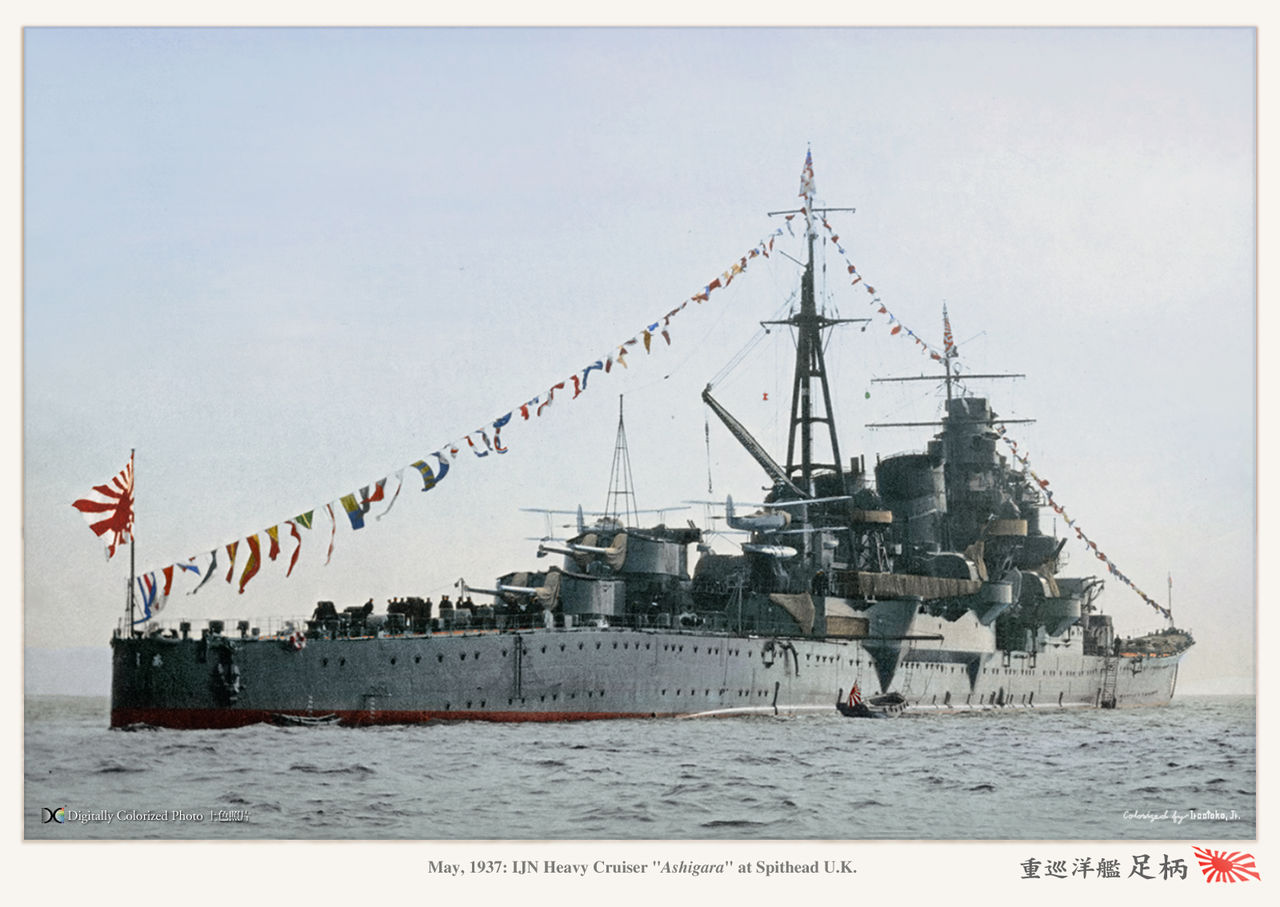
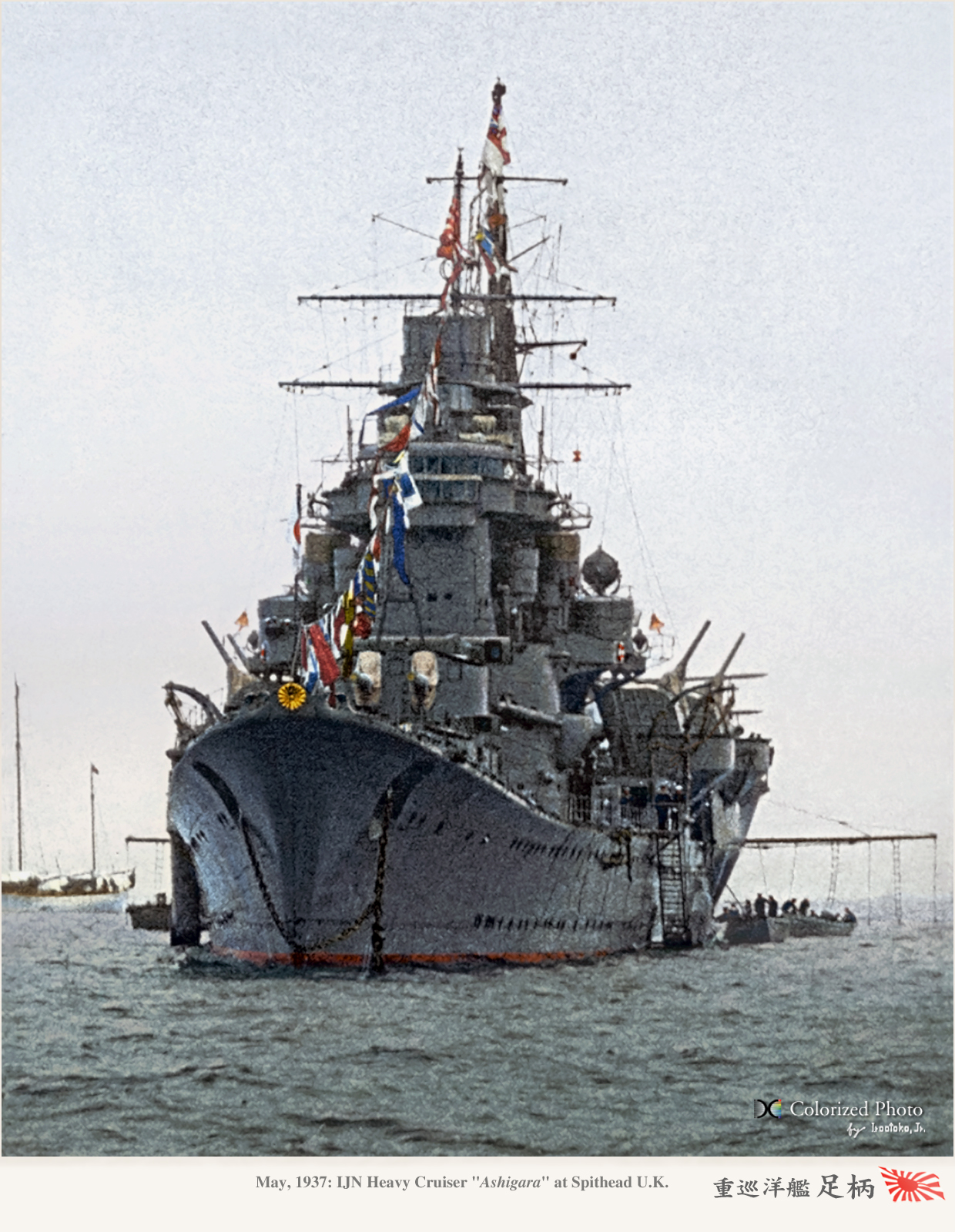
IJN Ashigara at the Spithead coronation naval review in 1937
Like the other cruisers of her class, IJN Ashigara was first training at Sasebo Naval District, in Sentai-4, 3rd Fleet. She was flagship of Sentai 4 (Vice Admiral Nobutarō Iida) and after a review had her forward smokestack raised by two meters. She escorted transports in China after the first Shanghai Incident of February 1932, was in reserve in December 1932, and reaffected to Sentai-5. Refitted between 1933 and 1935, she was damaged this summer during training, off of Muroran, Hokkaido. There was a gun flashback during a gunnery exercise, which destroyed No.2 turret, killing 41. She was back in service in December. On 10 March 1937, she sailed to Europe, participating of the 1937 Spithead, coronation review for King George VI. On her way she stopped at Singapore, Aden, crossed the Suez Canal and stopped also in Malta and arrive din May in Portsmouth. After Spithead, she departed to Kiel in Germany and her crew was on leave to visit Berlin, while the senior staff was received by Adolf Hitler on 24 May 1937. On the 31 May, IJN Ashigara was present in the German Kriegsmarine Day naval review and momorial of the Battle of Jutland. She stopped at Gibraltar, Port Said and Colombo on her way back to Japan. She escorted further transports at the opening of the second sino-Japanese war, still as flagship of Sentai-5 (July). She led the main convoy in August.
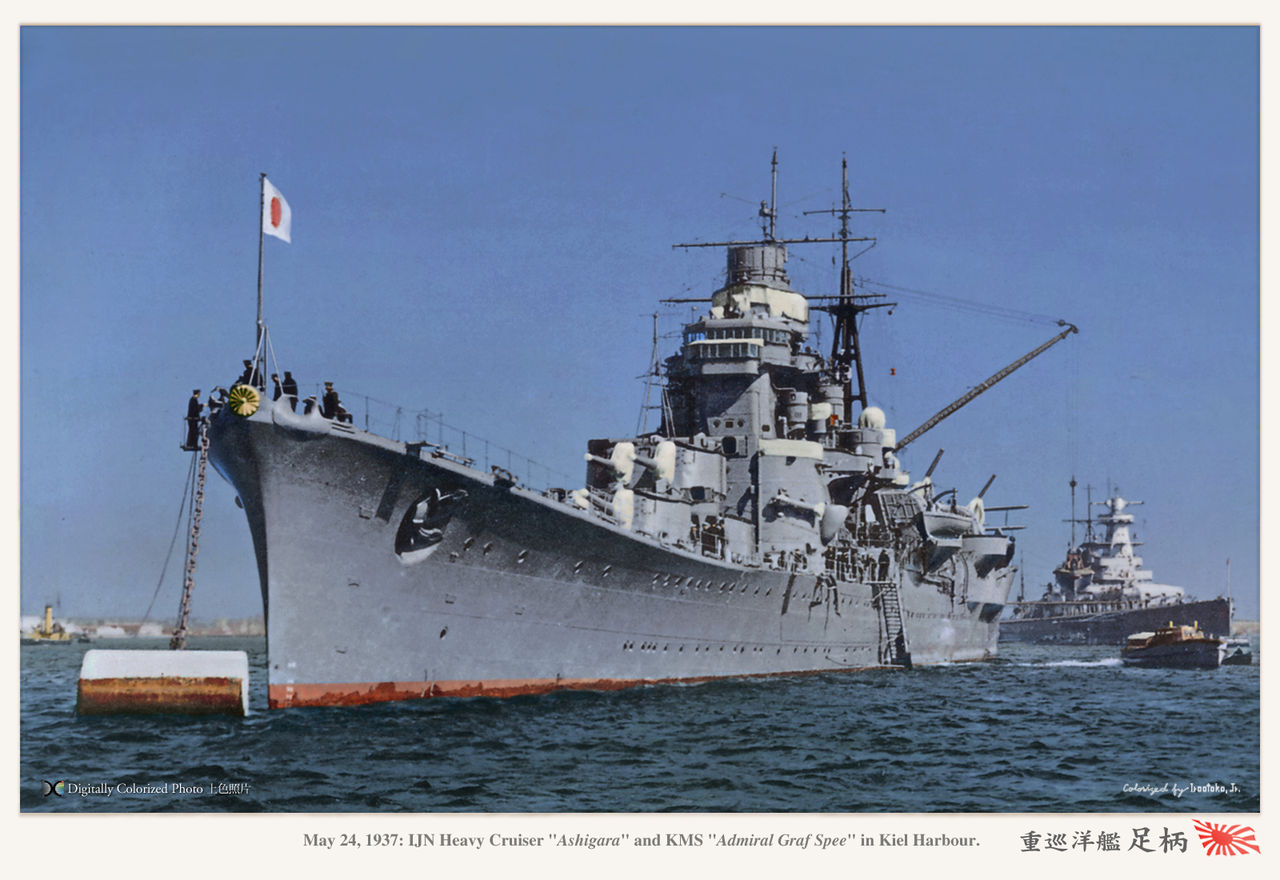
IJN Ashigara and Graf Spee in the background in Kiel naval celebrations, colorized by Irootoko jr.
On 11 December 1937 the ocean liner SS President Hoover ran aground in a typhoon off Taiwan and the nearby Ashigara arrived there in 14 hours to pick-up the stranded survivors. With a destroyer, they managed carry 330 crew and 503 passengers ashore. They were later repatriated by the liner SS President McKinley, and transfered were helped again by IJN Ashigara and her destroyer escort. The remainder were evacuated by SS President Pierce but the SS Hoover’s wreck was guarded by an USN destroyer until relieved by a Japanese destroyer.
On 15 December 1937, Captain Kuninori Marumo assumed command and later Captain Marquis Tadashige Daigo in 1938 while she underwent her second reconstruction. Until the end of it she was commanded by Captain Michiaki Kamada. This was over in October 1940 and she covered a convoy bound to the occupation of Vichy-French CochinChina on 29 July 1941. Back to Sasebo in August 1941, she becmame flagship for Vice Admiral Ibō Takahashi, Sentai-16. In December, Ashigara was off Mako Guard District (Pescadores islands) with Maya and Kuma. She assisted the invasion of northern Luzon. On 10 December she was under attack by nine PBY Catalina bombers (no hit). She was attacked by five B-17s on the 11. She covered landings at Balikpapan and also Makassar in the Dutch East Indies by February.
During the Battle of the Java Sea on 1 March 1942, Ashigara hit HMS Exeter multiple times and the destroyer HMS Encounter, sharing the kills with Haguro. On 10 March 1942, she became flagship, for the Second Southern Expeditionary Fleet. The latter participated led invasion of Christmas Island, on 26 May 1942. She also became flagship of the Southwest Area Fleet from 10 April 1942. After a stop in Japan in June for maintenance and repairs, she was back to Makassar in July and until the end of the year, spent her time escorting rapid troop transports from Surabaya. Dry-docked at Seletar Naval Base, Singapore she was there in January 1943.
Until early 1944, IJN Ashigara escorted troop transports. Shhe returned in April 1943 in Yokosuka for a refit and receive a Type 21 radar and i February 1944, was reaffected to the 5th Fleet, northern waters receiving a Type 22 surface-search radar. She was based in Ōminato Guard District with Nachi during the summer. Refitted at Kure Naval Arsenal in September 1944 she was ma de ready for the upcoming Battle of Leyte Gulf in October. Under Captain Hayao Miura, as part of Vice Admiral Kiyohide Shima’s force, she teamed with Nachi and eight destroyers. This force entered Surigao Strait on 25 October, following the destruction of Shōji Nishimura’s First Raiding Force, Fusō, Yamashiro and their escorts. They were ambushed by Rear Admiral Jesse B. Oldendorf. IJN Ashigara and Nachi fired their torpedoes and retreated. IJN Ashigara took refuge in Palawan, and headed to Brunei, departing again on 17 November with Haruna and Ōyodo, for the Spratly Islands. Under Vice Admiral Shima’s force she headed for Cam Ranh Bay in Indochina on 14 December. With Ōyodo and 6 destroyers she joined the Raiding Force on Mindoro where a landing was taking place. Spotted en route, they were soon attacked by B-25 Mitchell bombers and Ashigara was damaged by a direct hit, but arrived nonetheless and shelled American positions, spending 200 shells before retreating to Cam Ranh Bay on 29 December 1944.
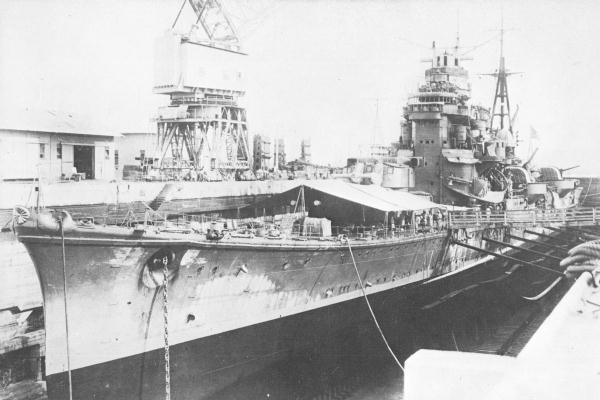
IJN Ashigara drydocked in Singapore, 1942
On 26 January 1945, she was in drydock maintenance in Singapore and repairs. On 5 February, as part of the 10th Area Fleet she spent five months as a troop and supply transport in the Dutch East Indies and Bay of Bengal, and while underway on 22 April, was attacked by HNLMS O 19, which missed. On 7 June 1945, she sailed from Batavia to Singapore with 1,600 troops on board when she was ambushe dunderway by the USS Blueback, reporting their position but too slow to take an attack position. The report went to HMS Trenchant and HMS Stygian, which took positions on the northern end of Bangka Strait. On the morning of 8 June 1945 IJN Kamikaze, which escorted Ashigara, spotted HMS Trenchant on the surface and opened fire. The sub plunger immediatemy and both lost contact, and the destroyer found afterwards HMS Stygian. Meanwnile, HMS Trenchant, now at persicopic depht, spotted the following Ashigara and prepared a torpedo attack abaft her starboard beam. Eight torpedoes left her bow tubes around midday and the cruiser attempted to turn starboard but cannot complete the maneuver in time. She took five hits, from 4,700 yards (4,300 m). Trenchant maneuvered and fired her stern tubes, but both missed. Ashigara took immediately a heavy list but sank slowly. IJN Kamikaze, lost contact with Stygian and returned for Trenchant, which submerged and escaped. She rescued 400 Japanese Army troops, 853 crewmen, including, Rear Admiral Miura. Still, 1200 troops and 100 crewmen drawned.
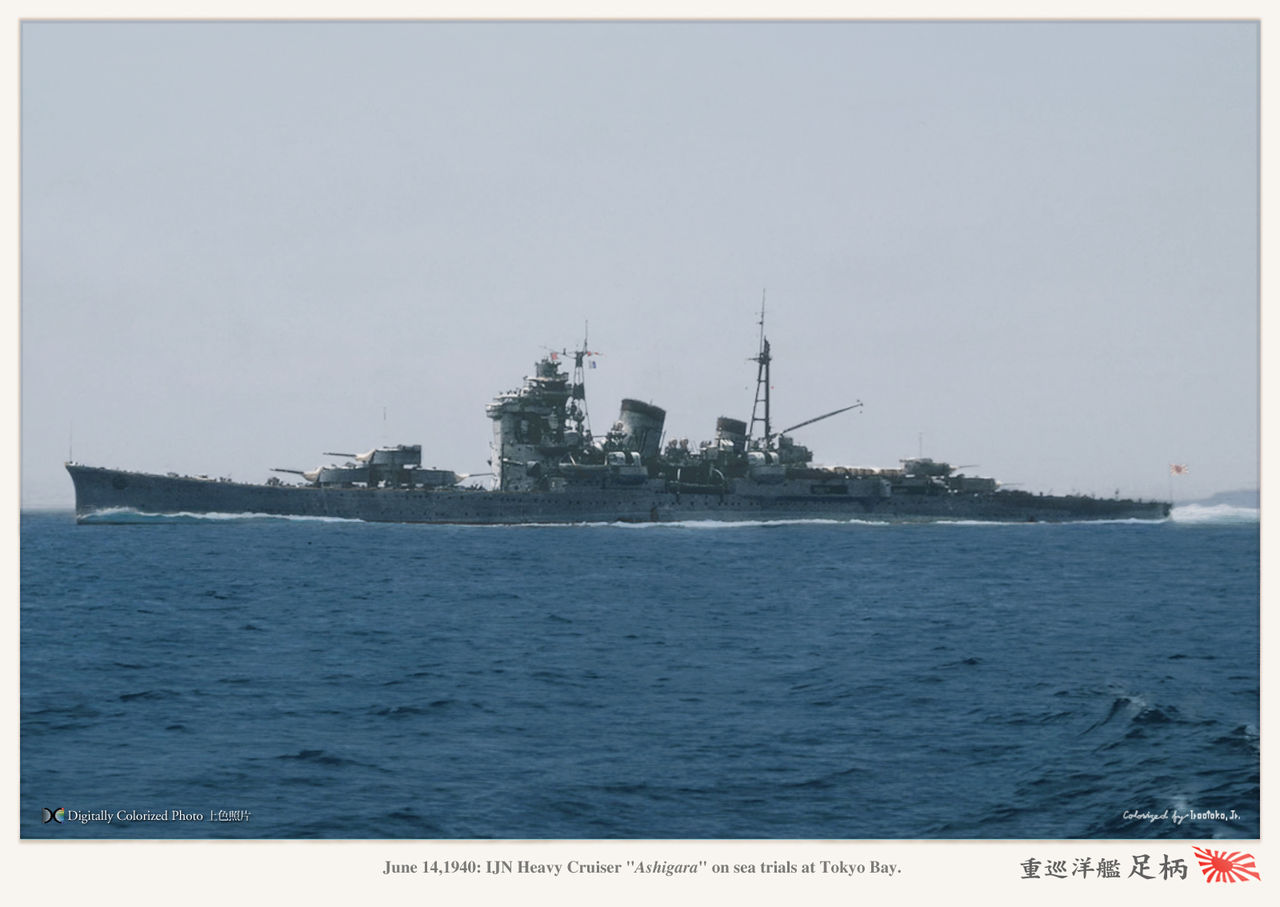
IJN Ashigara in 1940 post-refit sea trials, colorized by irootoko jr.



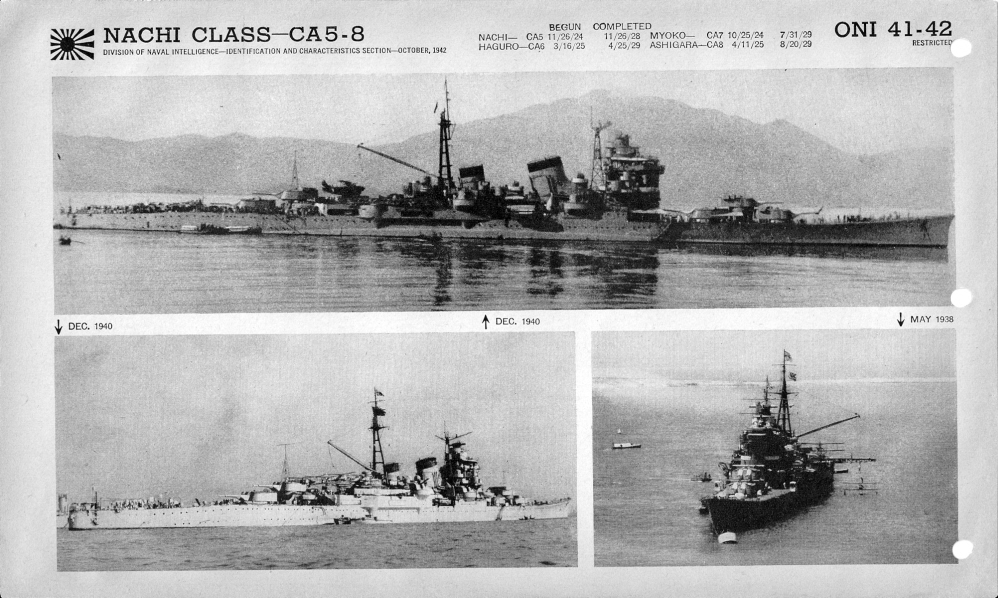

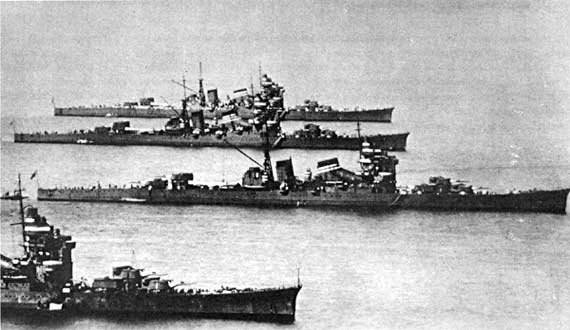
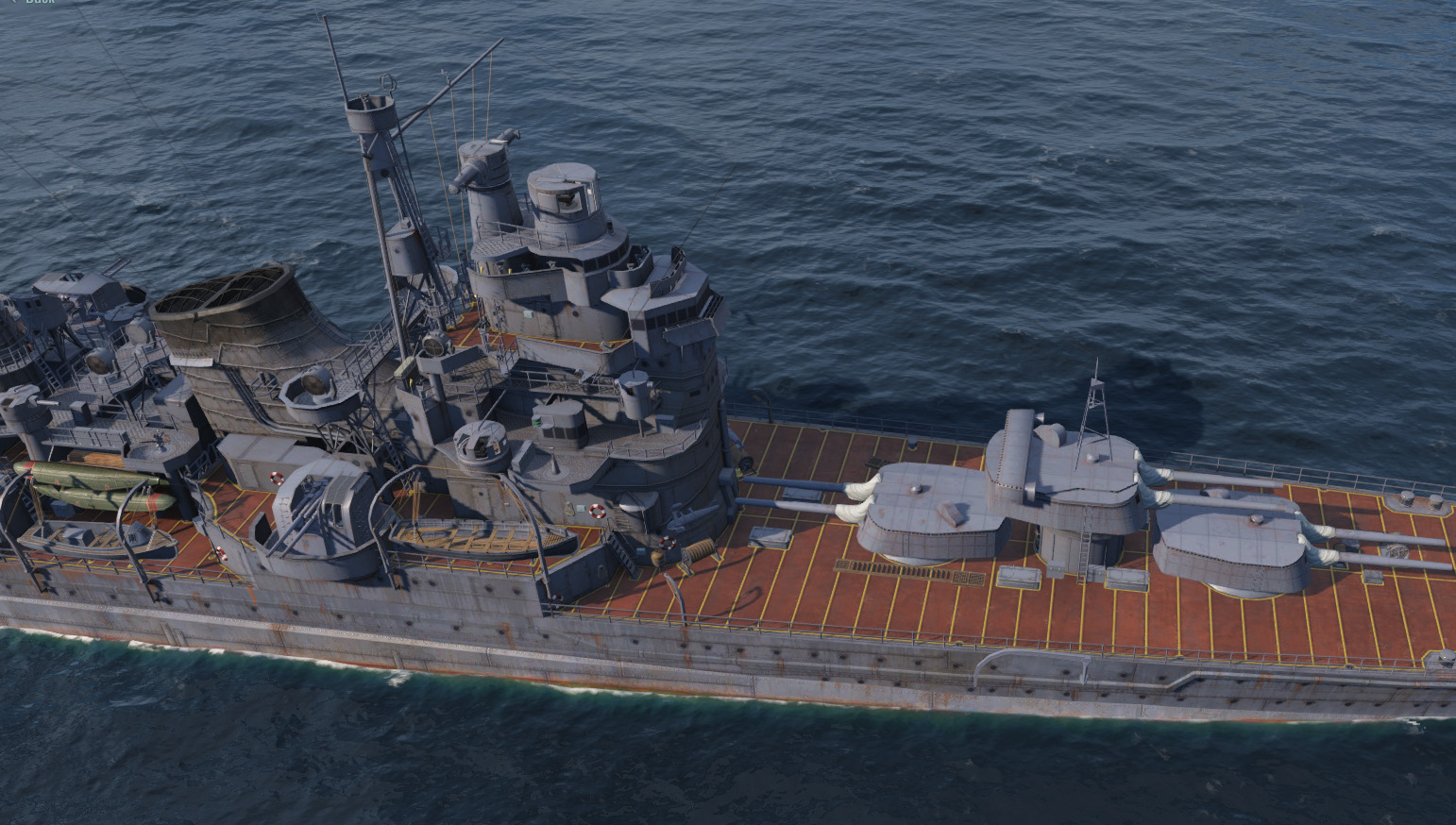
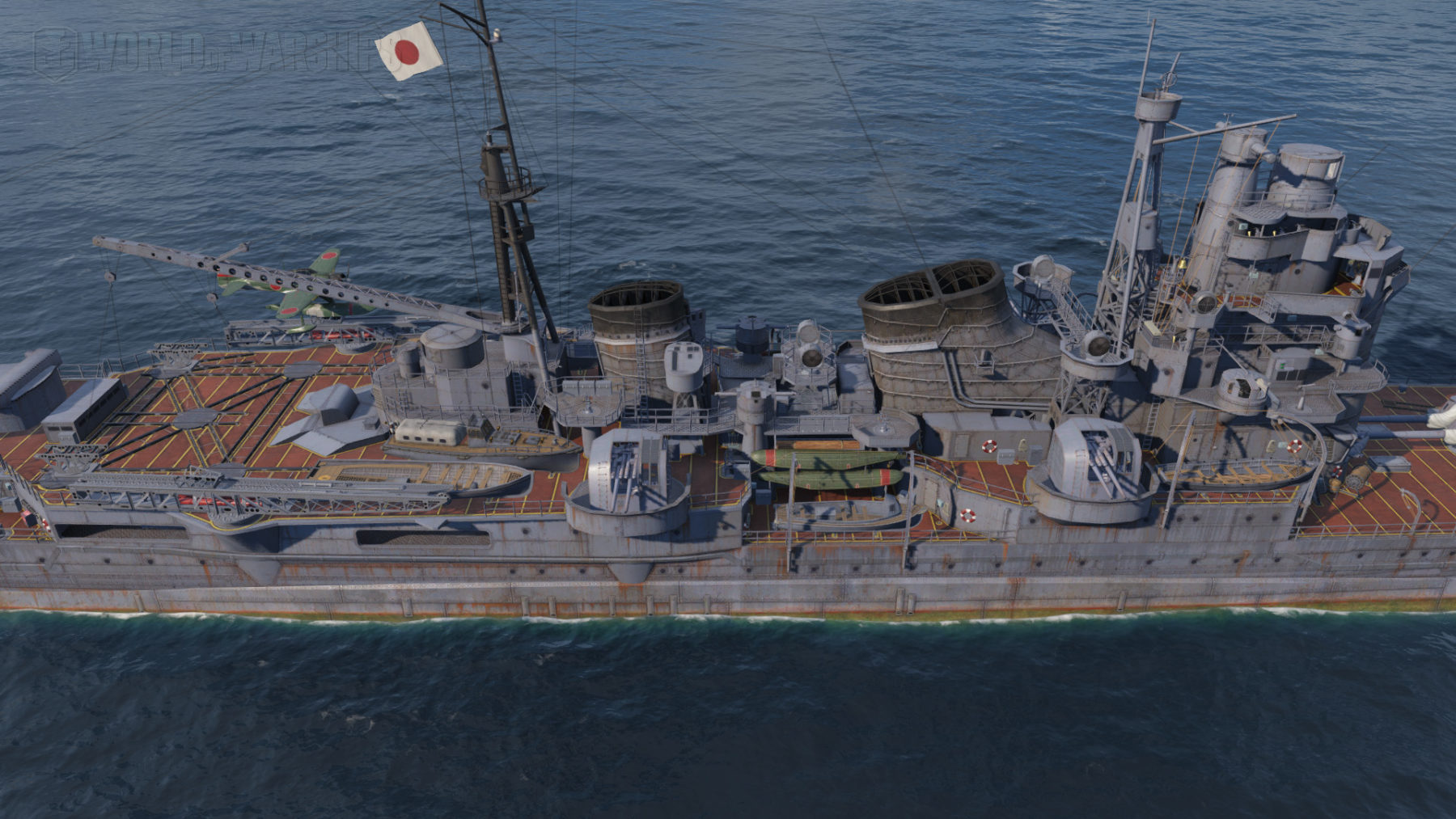
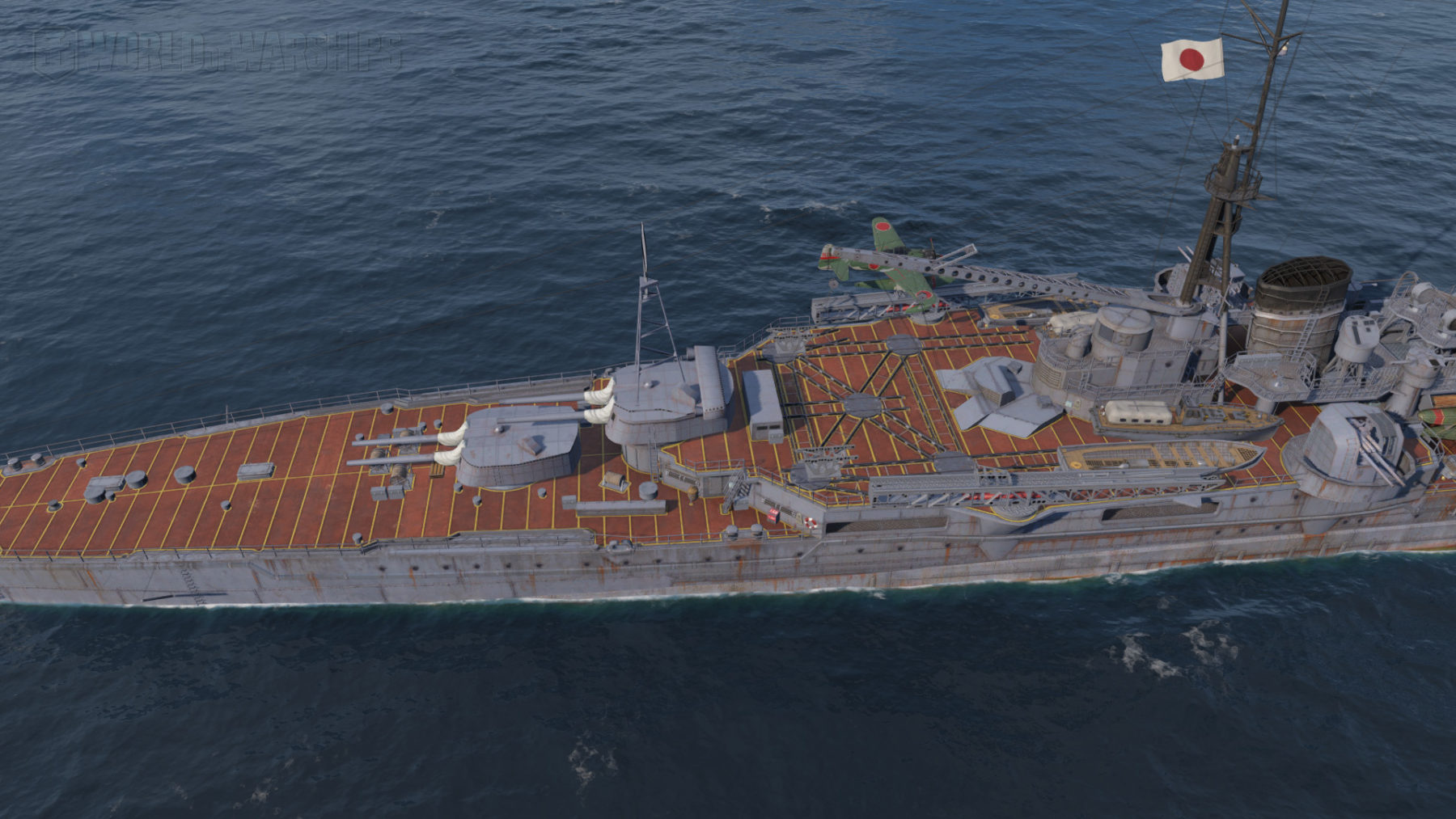
 Latest Facebook Entry -
Latest Facebook Entry -  X(Tweeter) Naval Encyclopedia's deck archive
X(Tweeter) Naval Encyclopedia's deck archive Instagram (@navalencyc)
Instagram (@navalencyc)





 French Navy
French Navy Royal Navy
Royal Navy Russian Navy
Russian Navy Armada Espanola
Armada Espanola Austrian Navy
Austrian Navy K.u.K. Kriegsmarine
K.u.K. Kriegsmarine Dansk Marine
Dansk Marine Nautiko Hellenon
Nautiko Hellenon Koninklije Marine 1870
Koninklije Marine 1870 Marinha do Brasil
Marinha do Brasil Osmanlı Donanması
Osmanlı Donanması Marina Do Peru
Marina Do Peru Marinha do Portugal
Marinha do Portugal Regia Marina 1870
Regia Marina 1870 Nihhon Kaigun 1870
Nihhon Kaigun 1870 Preußische Marine 1870
Preußische Marine 1870 Russkiy Flot 1870
Russkiy Flot 1870 Svenska marinen
Svenska marinen Søværnet
Søværnet Union Navy
Union Navy Confederate Navy
Confederate Navy Armada de Argentina
Armada de Argentina Imperial Chinese Navy
Imperial Chinese Navy Marinha do Portugal
Marinha do Portugal Mexico
Mexico Kaiserliche Marine
Kaiserliche Marine 1898 US Navy
1898 US Navy Sovietskiy Flot
Sovietskiy Flot Royal Canadian Navy
Royal Canadian Navy Royal Australian Navy
Royal Australian Navy RNZN Fleet
RNZN Fleet Chinese Navy 1937
Chinese Navy 1937 Kriegsmarine
Kriegsmarine Chilean Navy
Chilean Navy Danish Navy
Danish Navy Finnish Navy
Finnish Navy Hellenic Navy
Hellenic Navy Polish Navy
Polish Navy Romanian Navy
Romanian Navy Turkish Navy
Turkish Navy Royal Yugoslav Navy
Royal Yugoslav Navy Royal Thai Navy
Royal Thai Navy Minor Navies
Minor Navies Albania
Albania Austria
Austria Belgium
Belgium Columbia
Columbia Costa Rica
Costa Rica Cuba
Cuba Czechoslovakia
Czechoslovakia Dominican Republic
Dominican Republic Haiti
Haiti Hungary
Hungary Honduras
Honduras Estonia
Estonia Iceland
Iceland Eire
Eire Equador
Equador Iran
Iran Iraq
Iraq Latvia
Latvia Liberia
Liberia Lithuania
Lithuania Mandchukuo
Mandchukuo Morocco
Morocco Nicaragua
Nicaragua Persia
Persia San Salvador
San Salvador Sarawak
Sarawak Uruguay
Uruguay Venezuela
Venezuela Zanzibar
Zanzibar Warsaw Pact Navies
Warsaw Pact Navies Bulgaria
Bulgaria Hungary
Hungary

 Bundesmarine
Bundesmarine Dutch Navy
Dutch Navy Hellenic Navy
Hellenic Navy Marina Militare
Marina Militare Yugoslav Navy
Yugoslav Navy Chinese Navy
Chinese Navy Indian Navy
Indian Navy Indonesian Navy
Indonesian Navy JMSDF
JMSDF North Korean Navy
North Korean Navy Pakistani Navy
Pakistani Navy Philippines Navy
Philippines Navy ROKN
ROKN Rep. of Singapore Navy
Rep. of Singapore Navy Taiwanese Navy
Taiwanese Navy IDF Navy
IDF Navy Saudi Navy
Saudi Navy Royal New Zealand Navy
Royal New Zealand Navy Egyptian Navy
Egyptian Navy South African Navy
South African Navy






























 Ukrainian Navy
Ukrainian Navy dbodesign
dbodesign